Introduction

Most rangefinder lenses used on a Sony a7 series camera show some serious issues because of the rather thick filter stack in front of the sensor. There are two ways to deal with this. We have previously discussed the use of front filters to counter the induced field curvature. In this article Sebboh reviews another solution.
This is an extended use review of the Kolari Ultra Thin (UT, also sometimes referred to as version 4) sensor stack modification on a Sony A7. This modification removes the AA filter and IR cut filter from a stock Sony camera and replaces it with an ultra thin 0.2mm thick IR cut filter in order to attempt to provide similar levels of performance to the Leica M9 in dealing with the steep ray angles often produced by rangefinder lenses designed for film. I have shot a UT modified Sony A7 for 6 months now and can confirm that it dramatically improves performance with certain lenses (big thanks to Nehemiah for letting me use his lenses and cameras for the comparisons shown here). I will try to outline what kind of improvements can be expected here and what drawbacks there are to getting the conversion done.
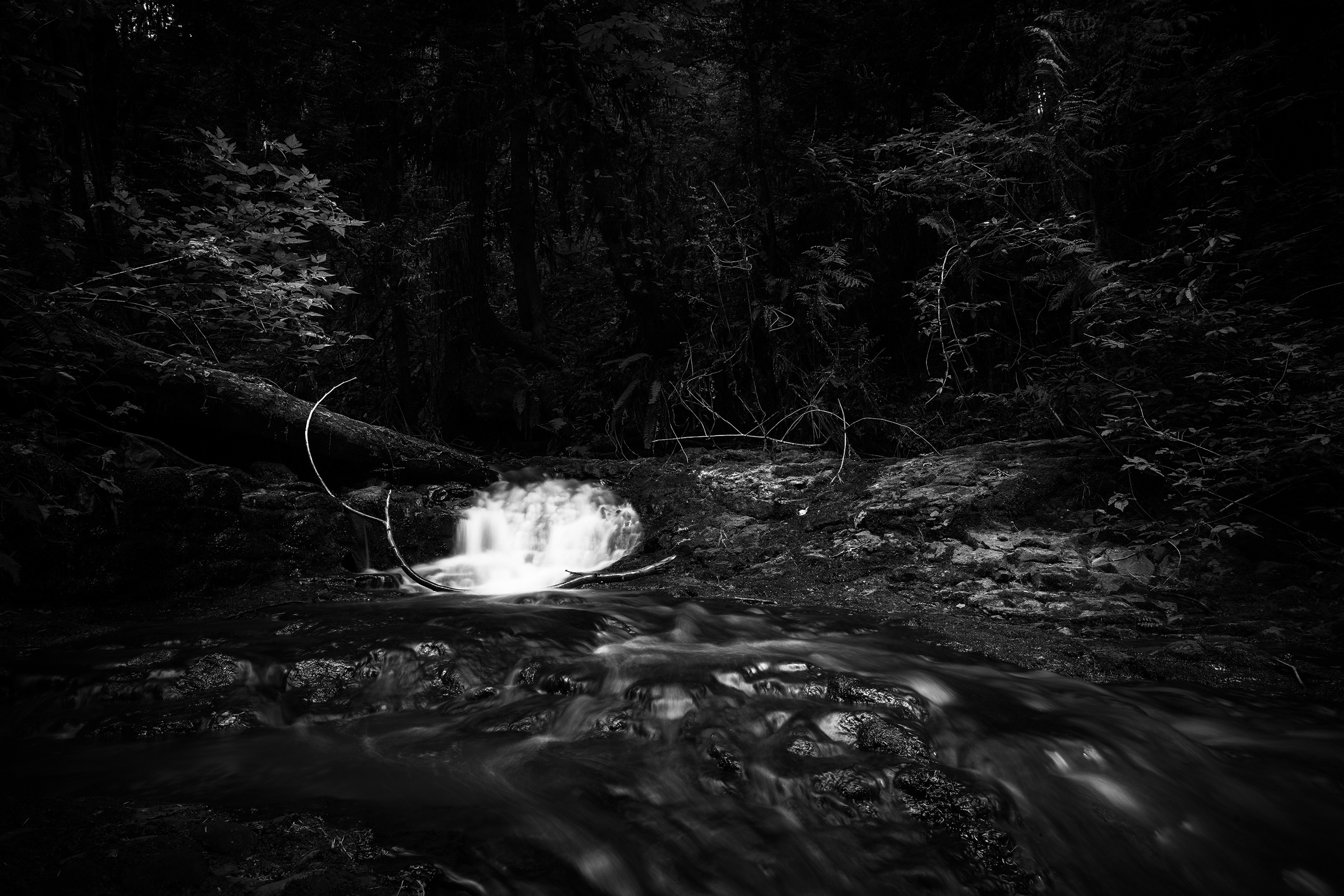
Contents
- Introduction
- Kolari UT modification – Summary
- Performance with digital era rangefinder lenses
- Performance with film era rangefinder lenses
- Compared to a Leica
- Performance with Native FE Lenses
- Performance with SLR Lenses
- Sensor Reflections
- Auto Focus
- White Balance
- Dust
- Aliasing
- Alternatives
- Conclusion
- Sample Images
- Support Us
- Further Reading
Kolari UT modification – Summary
- Costs $400 ($500 for the A9 and A7RIII)
- Dramatically improves performance of some rangefinder lenses
- Modestly improves the performance of some film era slr lenses
- Does nothing to mitigate color shift of rangefinder wide angle lenses
- Decreases performance of some native lenses
- Cripples camera based auto white balance
- Increases the effects of dust on the sensor
- Increases aliasing artifacts on cameras that had AA filters
Performance with digital era rangefinder lenses
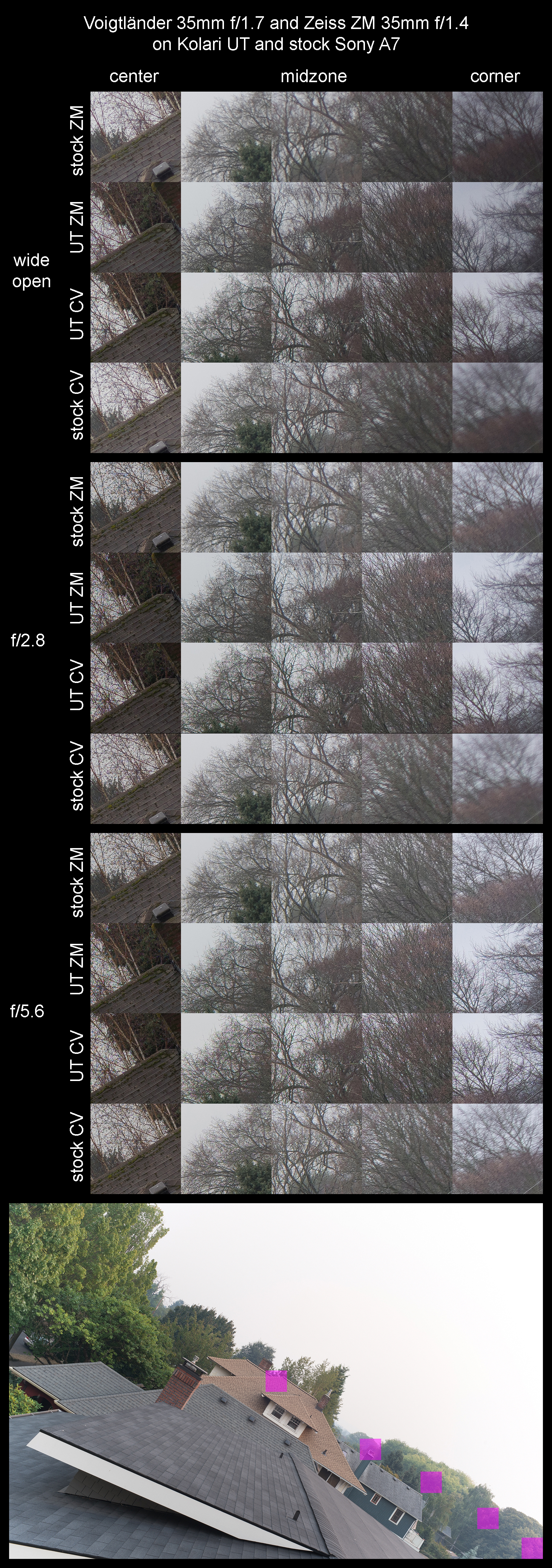
Improvements in performance with modern rangefinder wide angle lenses that were designed for digital are fantastic! Well corrected lenses like the ZM 35mm f/1.4 and CV 35mm f/1.7 go from needing to be stopped down to f/5.6 or f/8 for good corners and center to being able to shoot landscape wide open.
The improvements from the UT conversion with such lenses were also significantly better than what I could get using correction filters.
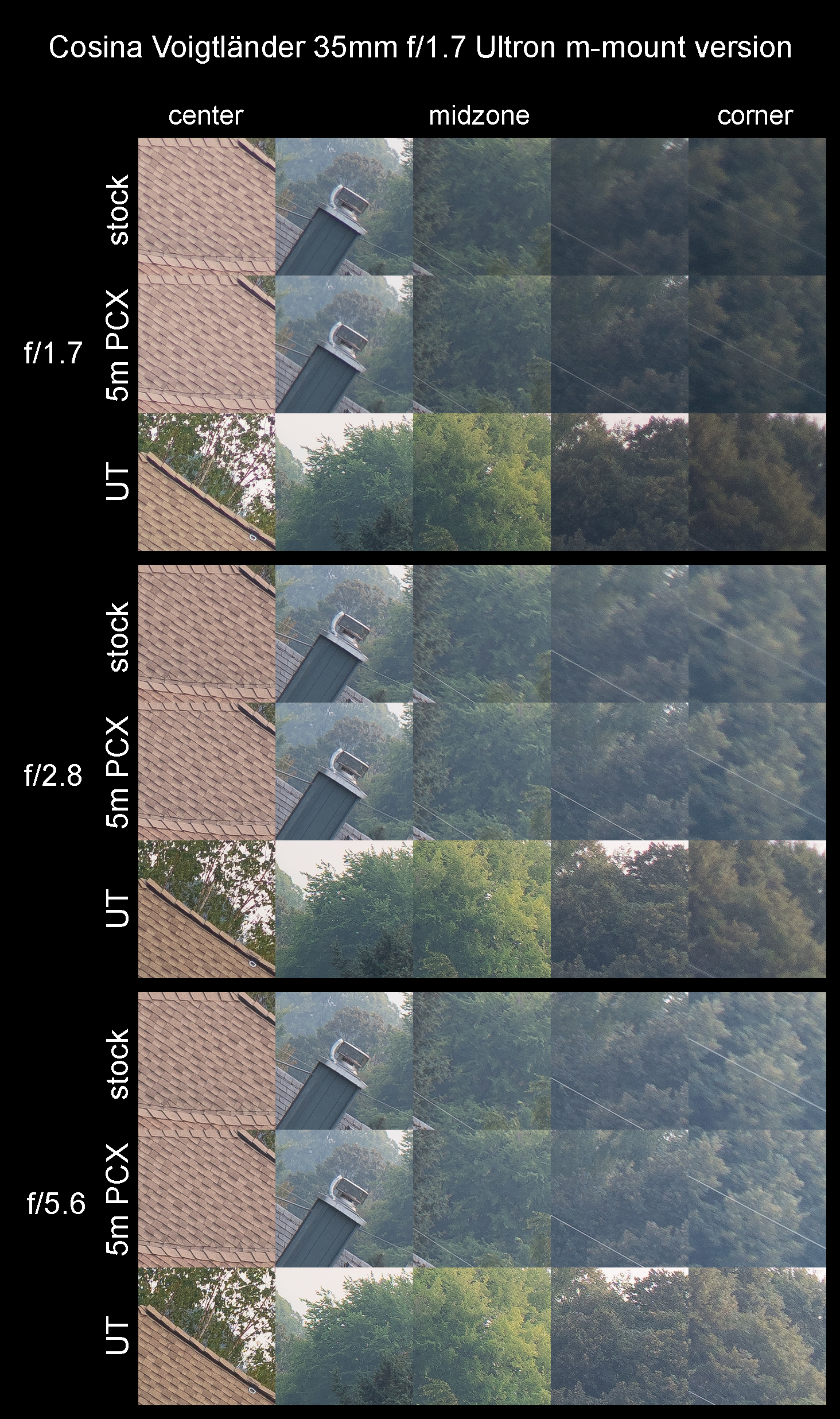
Less well corrected modern rangefinder lenses will show improvement, but the improvement will not be as dramatic for lenses that just are not that perfect to begin with or are longer focal lengths. At large apertures when focusing centrally, the ZM 50mm f/1.5 and CV 50mm f/1.5 both actually show better corners on the stock camera than the Kolari UT, though midzone performance is much better on the Kolari UT. This is because both of these lenses have M shaped field curvature by design. The thick sensor stack of the stock sony camera actually corrects the inward field curvature towards the corner while exacerbating the outward midzone field curvature.
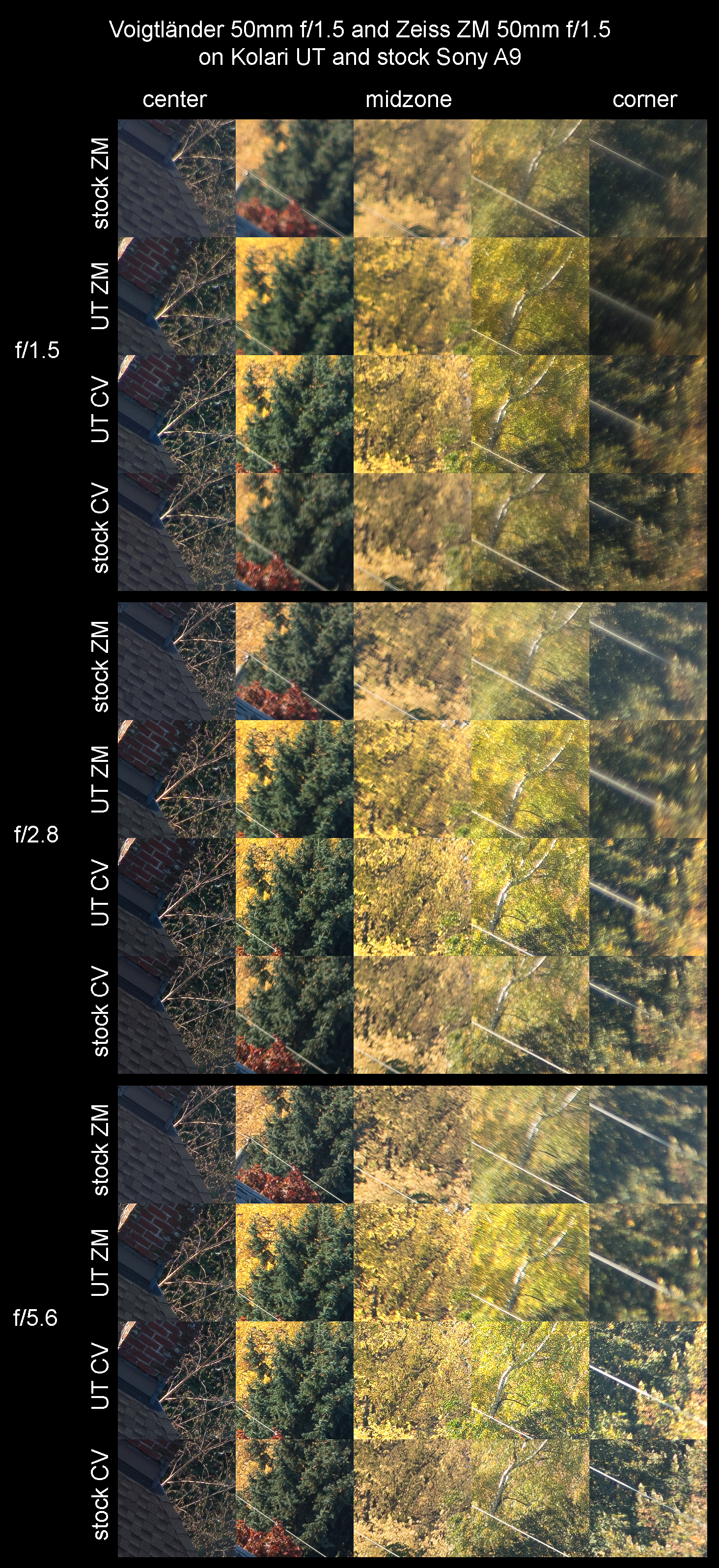
It’s not just shooting landscape and focused near infinity where you will see improvement though. Many lenses show decreased field curvature at closer focus distances and less spherical aberration at large apertures. Bokeh is dramatically improved across a number of lenses due to flattened field (or inward field curvature in some cases) and decreased corner aberrations.
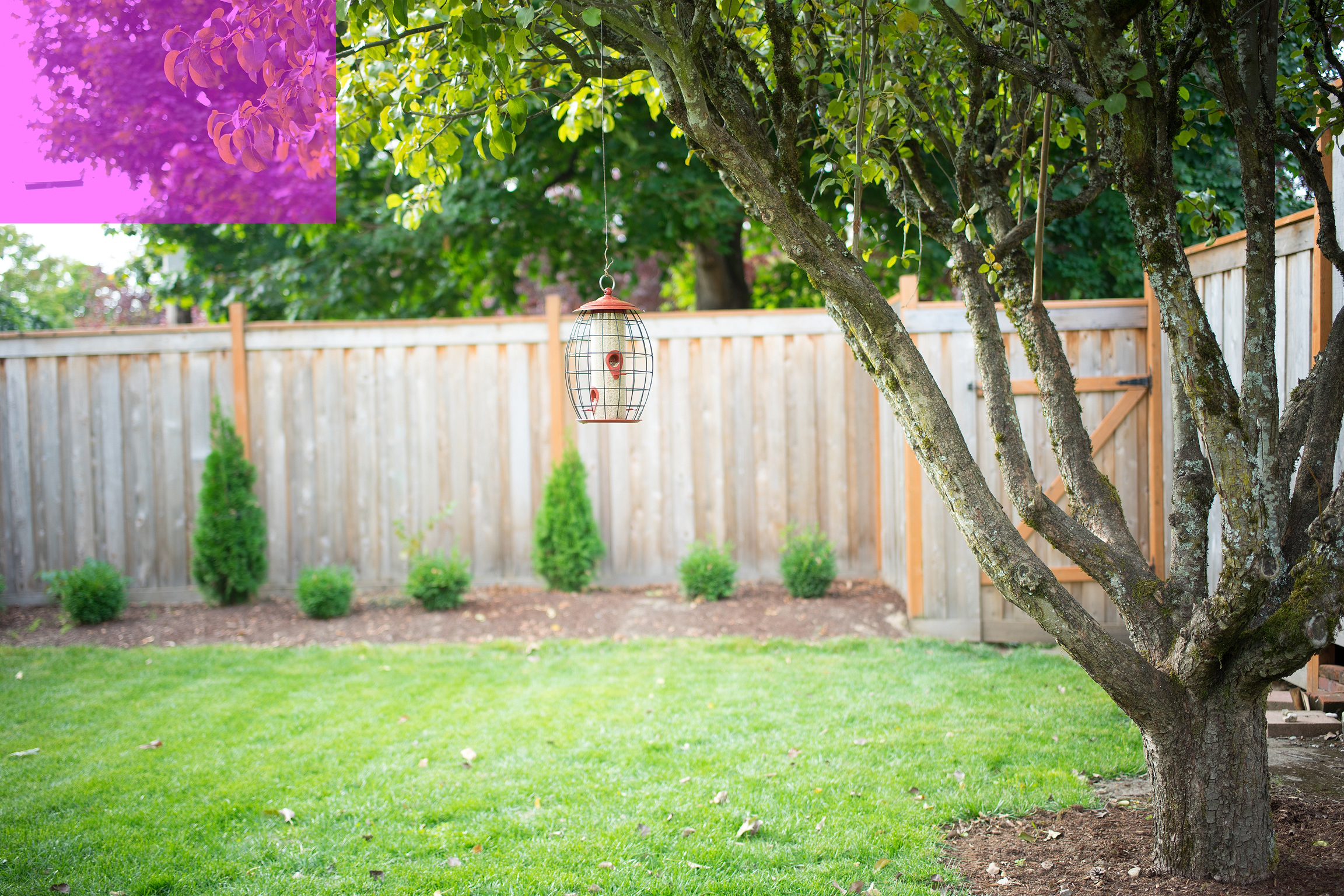
Performance with film era rangefinder lenses
Improvements on the Kolari UT mod with film era rangefinder lenses can be huge (particularly with symmetric ultra-wide angle lenses), however the most symmetrical wide angles often seem to fall short of the lens’s film performance/potential. The Contax G 21mm f/2.8 and Contax G 28mm f/2.8 are classic examples of this. On film these were two of the best performing lenses of their time (1990s), however on a stock A7 camera most people find them to be unusable due to field curvature and corner smearing (I still like the 28mm on a stock camera, but it requires a lot of attention to use). On the Kolari UT both of these lenses become excellent performers again, but still have noticeable field curvature that is not present on film (the addition of a planoconvex 5m filter can correct this).
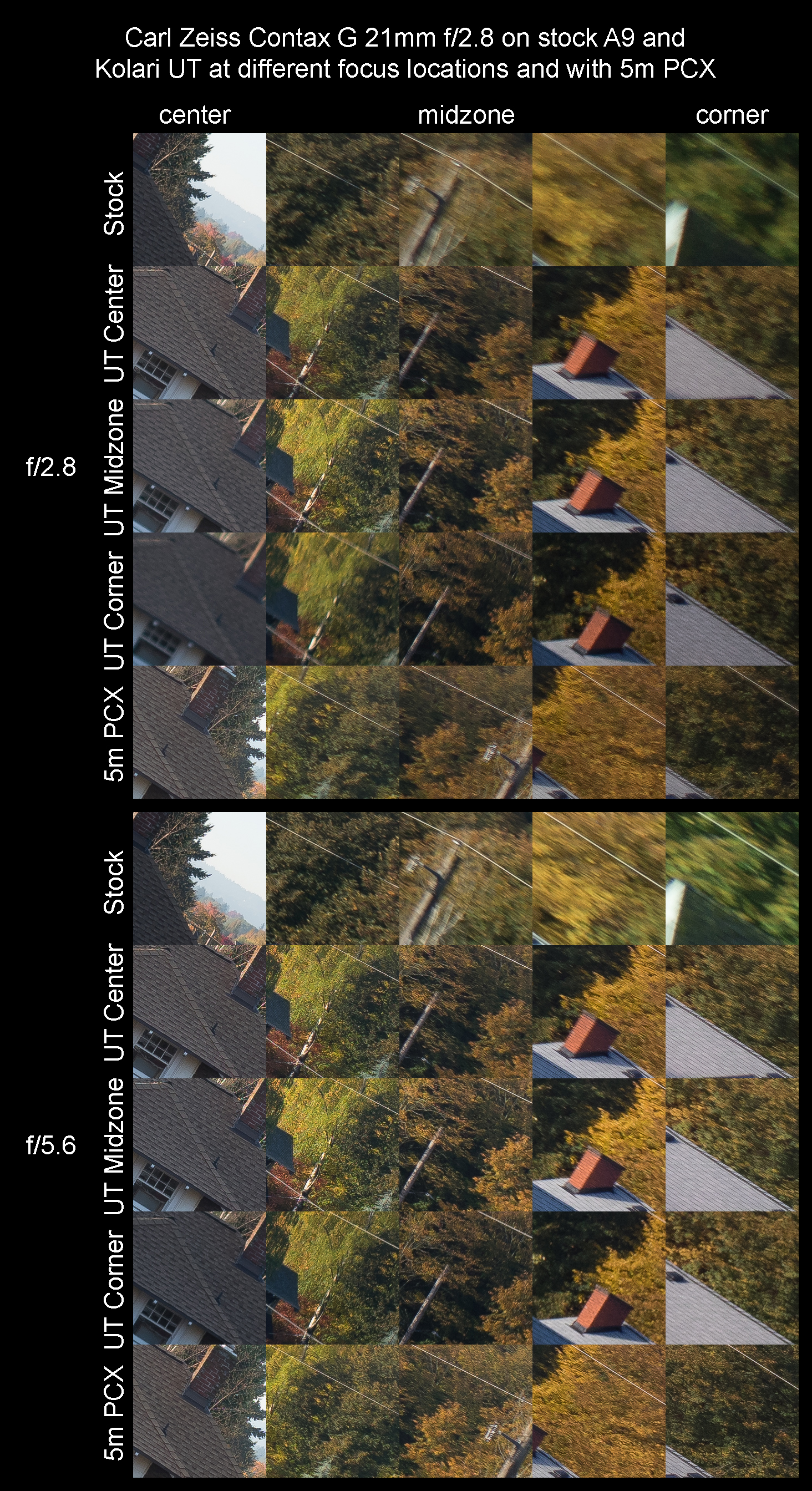

With the more symmetric wide angle designs such as the Contax G Biogons the UT thin filter mod does not correct field curvature as well as the correct front filter does, but it does better maintaining sharpness wherever you’re focus point is. This means that you can get sharper results at the focus point focusing outside of the central region with the UT mod than with a correction filter despite the greater field curvature. For across the frame sharpness the UT mod seems to be able to outperform the front correction filter if one balances the focus between the corner and center, but it is close – the UT provides better midzone performance while the correction filter provides better corners. Combining the UT mod with the appropriate correction filter, of course, provides the best results.
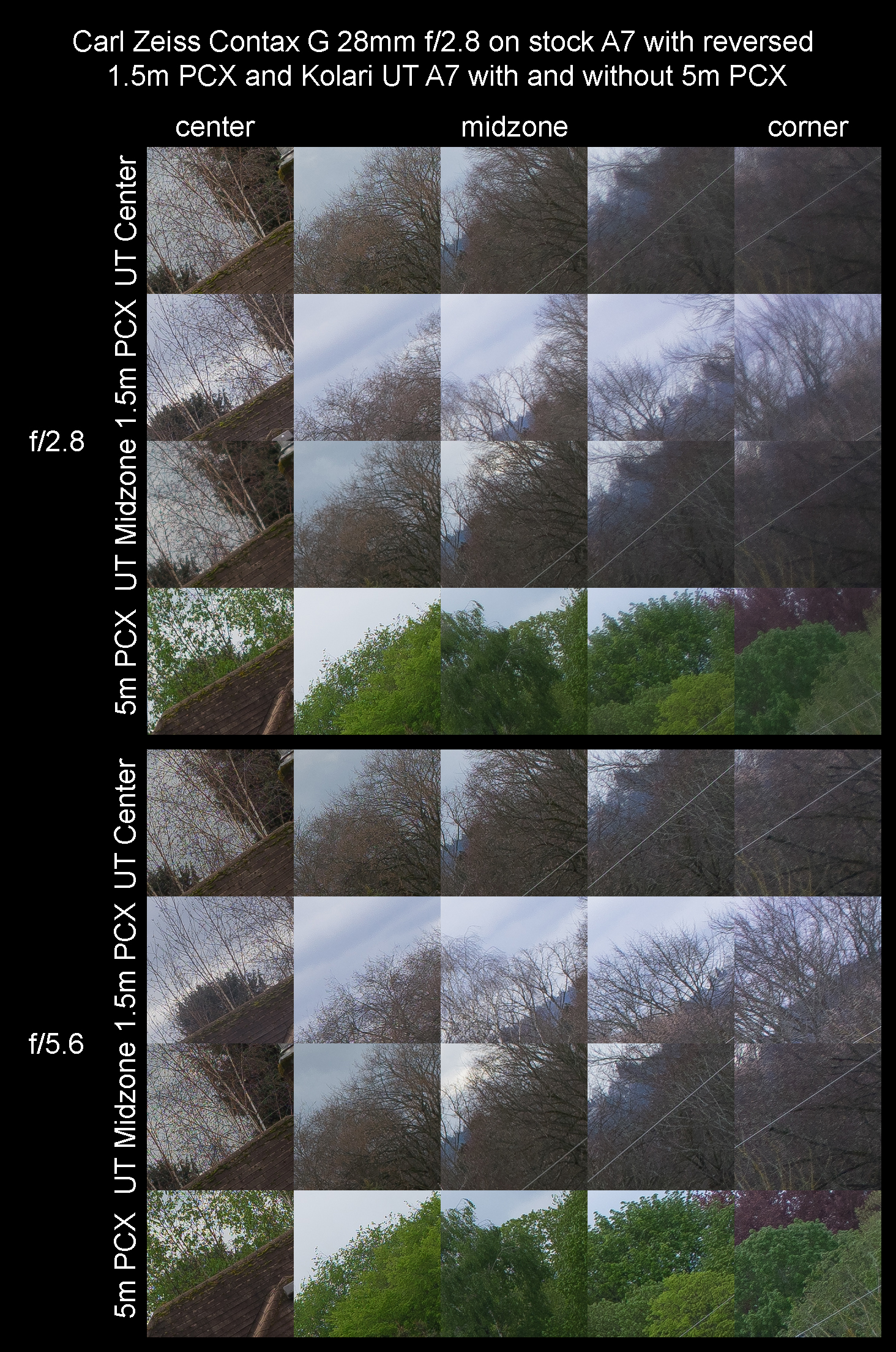
As with rangefinder lenses designed for digital, longer film era rangefinder lenses are less effected by the filter stack, but many still show an improvement. Again, the better corrected lenses tend to show greater improvement.
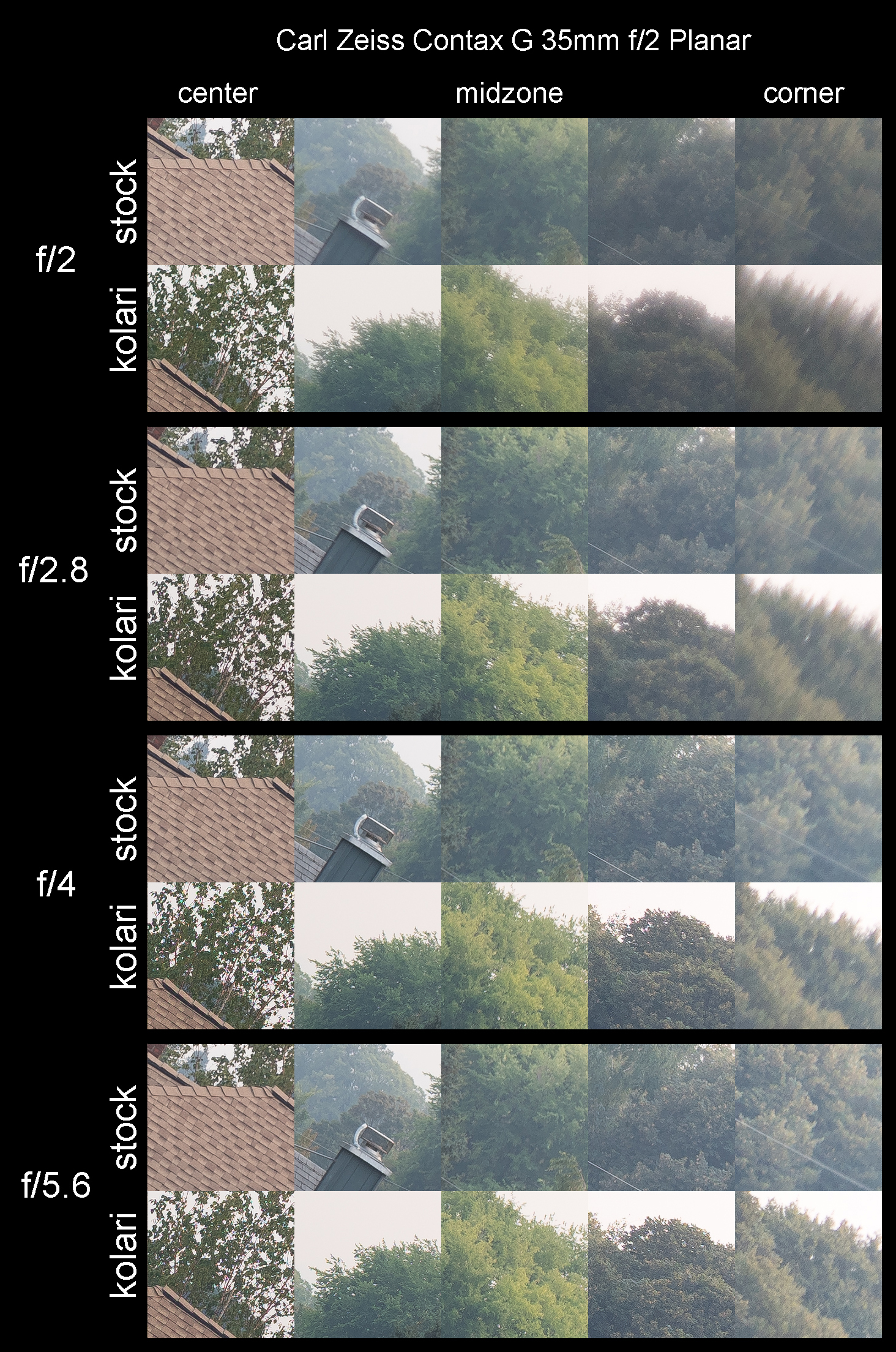
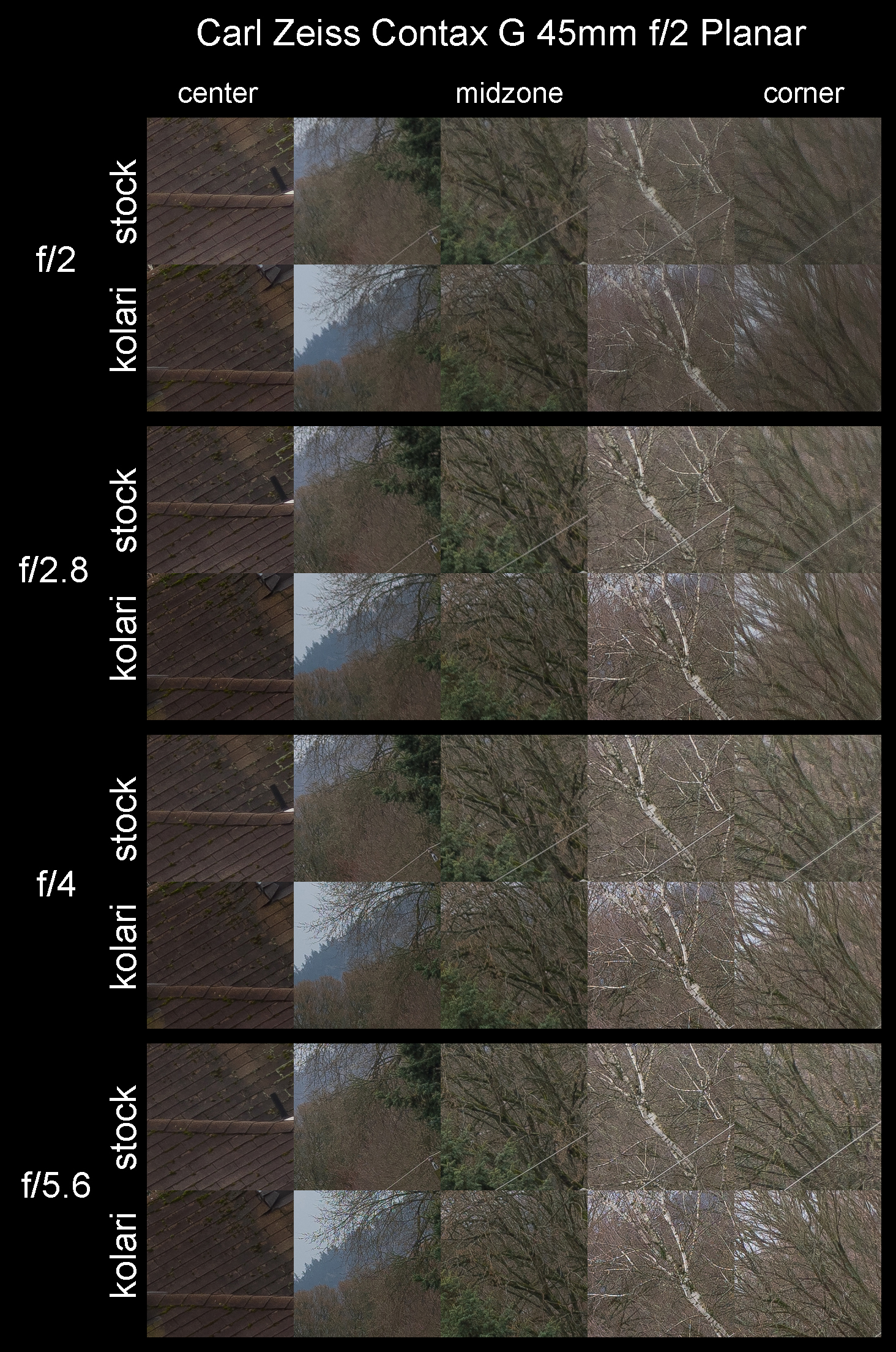
Compared to a Leica
Does the Kolari UT sensor modification match a Leica digital camera for performance with rangefinder lenses? I believe it almost certainly does. Thanks to a generous Leica shooter (Jon PB) and Nehemiah again, I was able to compare a number of rangefinder lenses (Leica 35/1.4 summilux FLE, ZM 35/1.4 Distagon, CV 35/1.7 Ultron, Leica 35/1.4 summilux pre-ASPH, Leica 21/2.8 ASPh) directly on a Leica M9 and my Kolari UT A7. In all cases performance looked the same with regard to field curvature, astigmatism, and bokeh. The extra megapixels of the Sony gave slightly better sharpness when images were scaled to the same size.
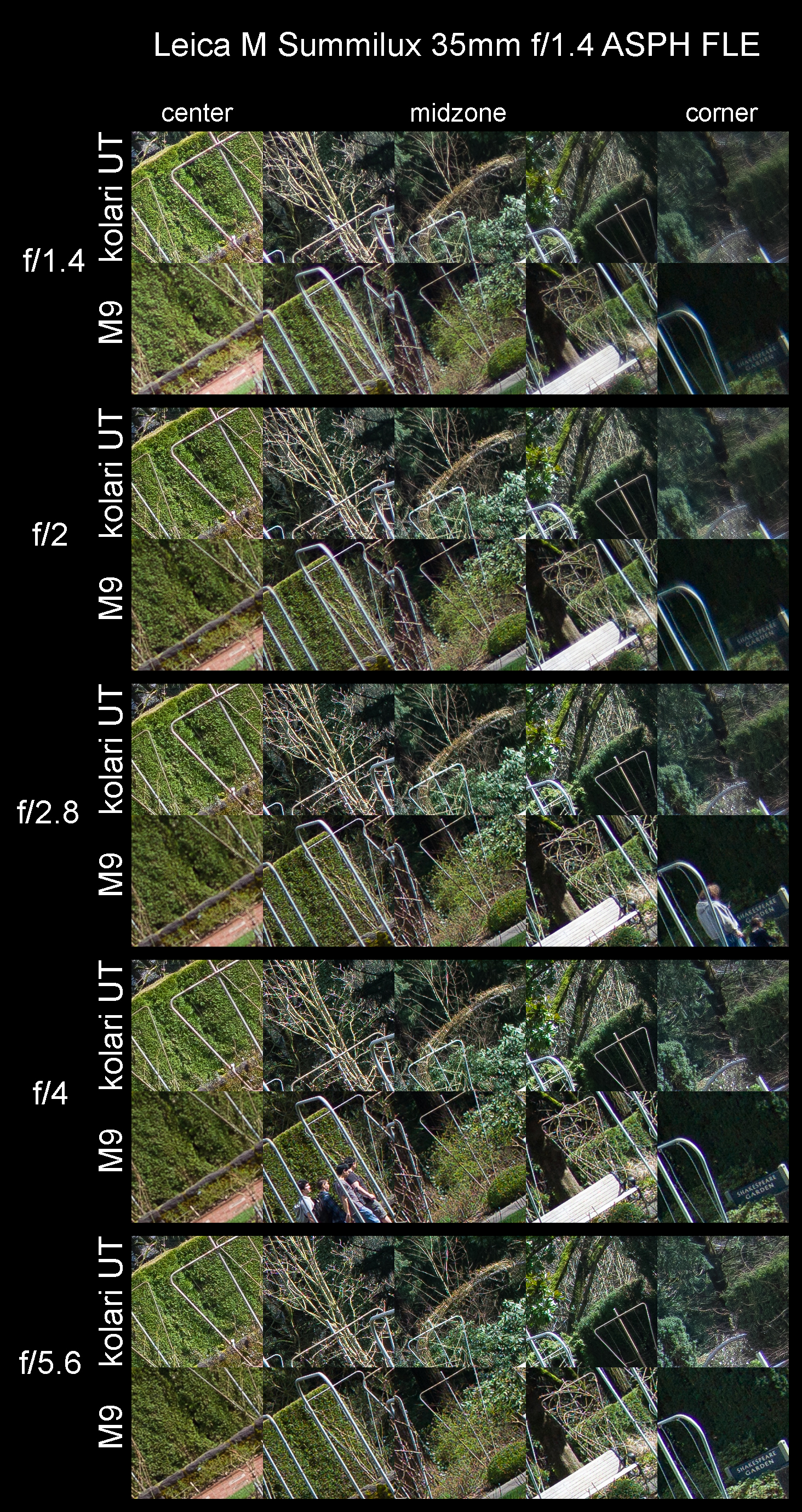
Leica cameras do still have the advantage of being able to automatically apply color correction profiles to Leica lenses for correction of color shift caused by extreme ray angles (and the whole shooting a rangefinder thing), but I have not found it to be terribly difficult to use the Lightroom flat field correction plug-in for this on lenses that really need it (like the Contax G 21/2.8 Biogon). Sony cameras with backlit sensors do not seem to need any correction.

Performance with Native FE Lenses
Native Sony FE mount lenses that have been designed for the thicker sensor stack can show definite detriments to performance on a Kolari UT modded camera. As with rangefinder lenses, it is the wider and faster lenses that show the biggest differences in general.
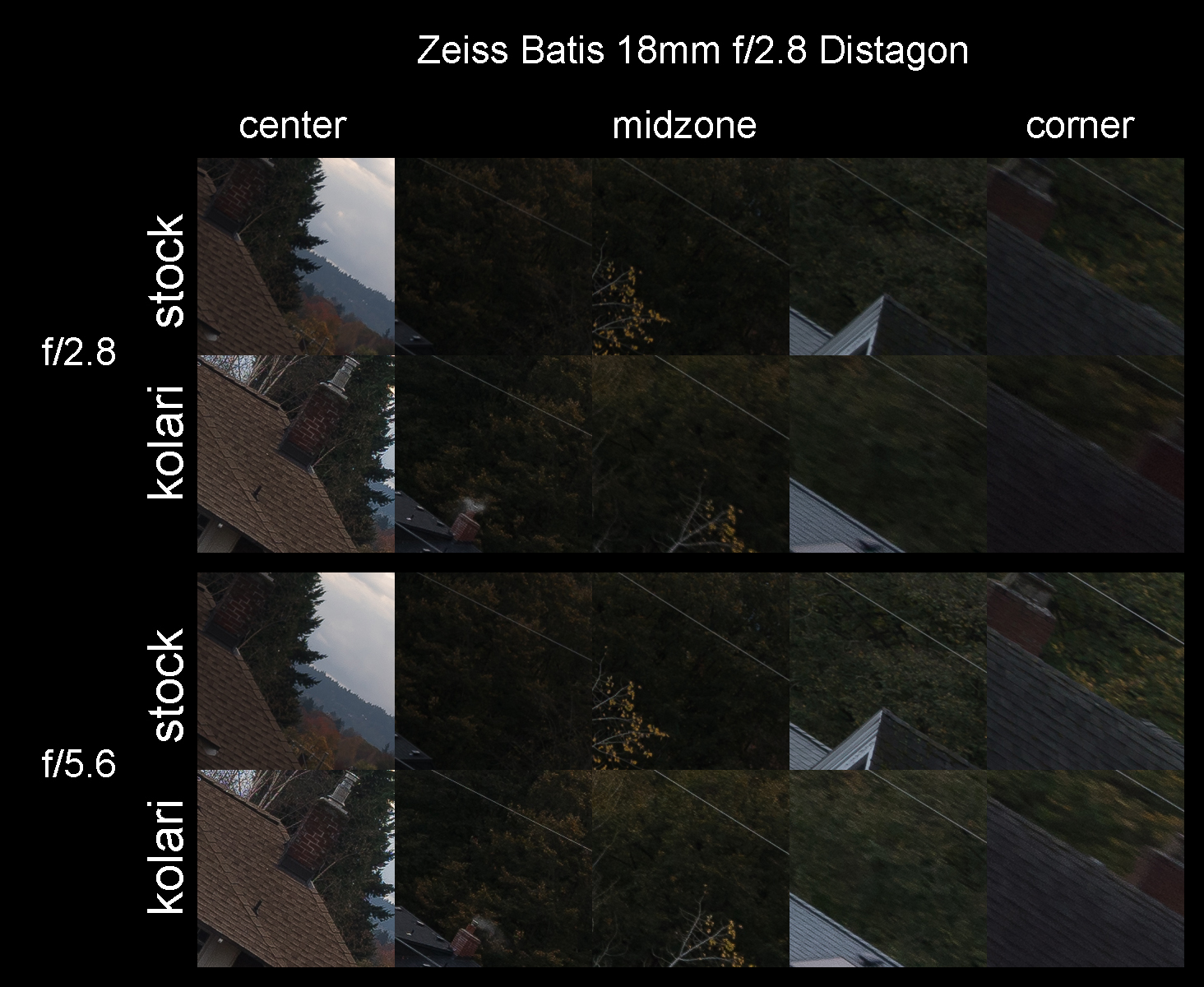
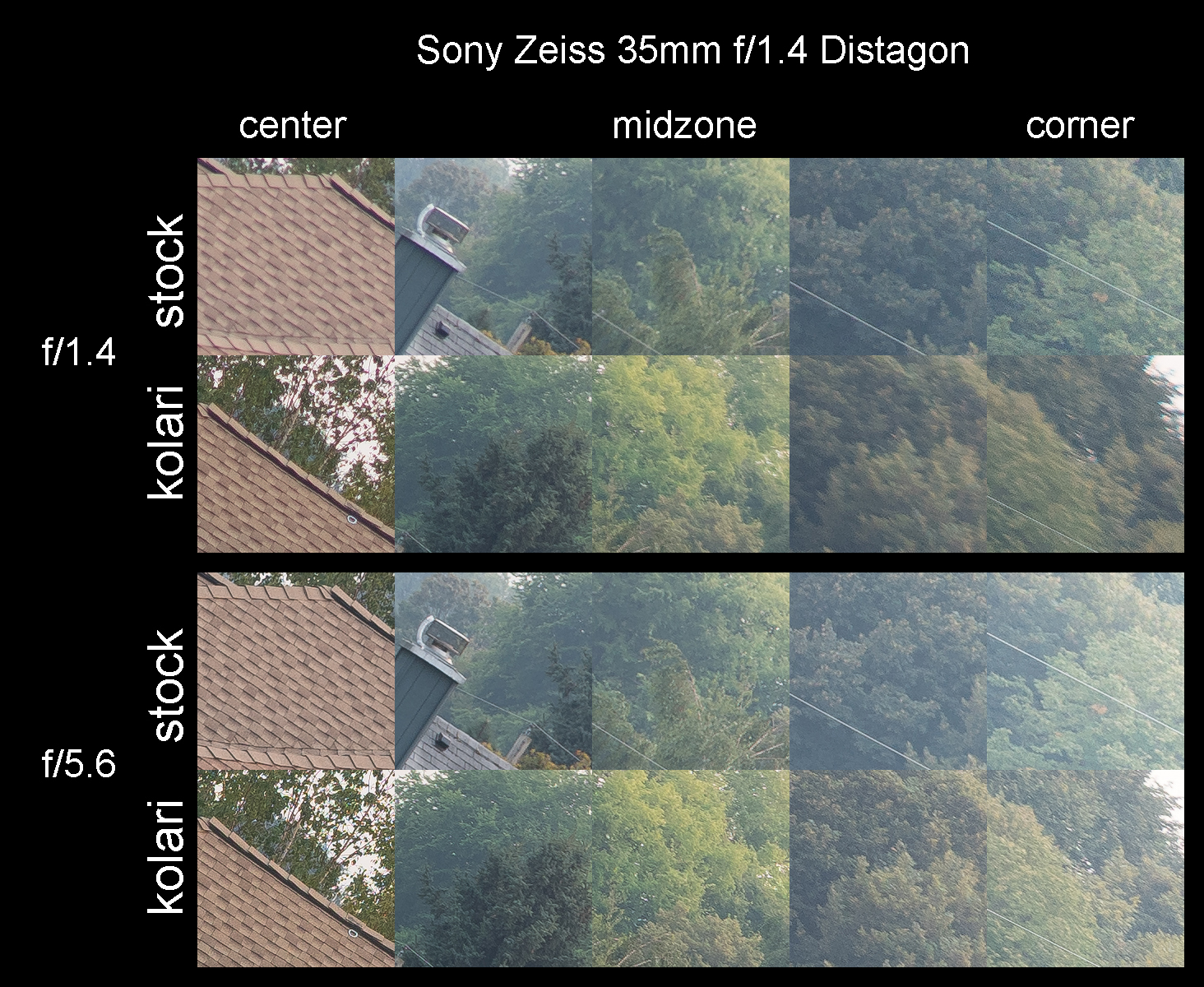
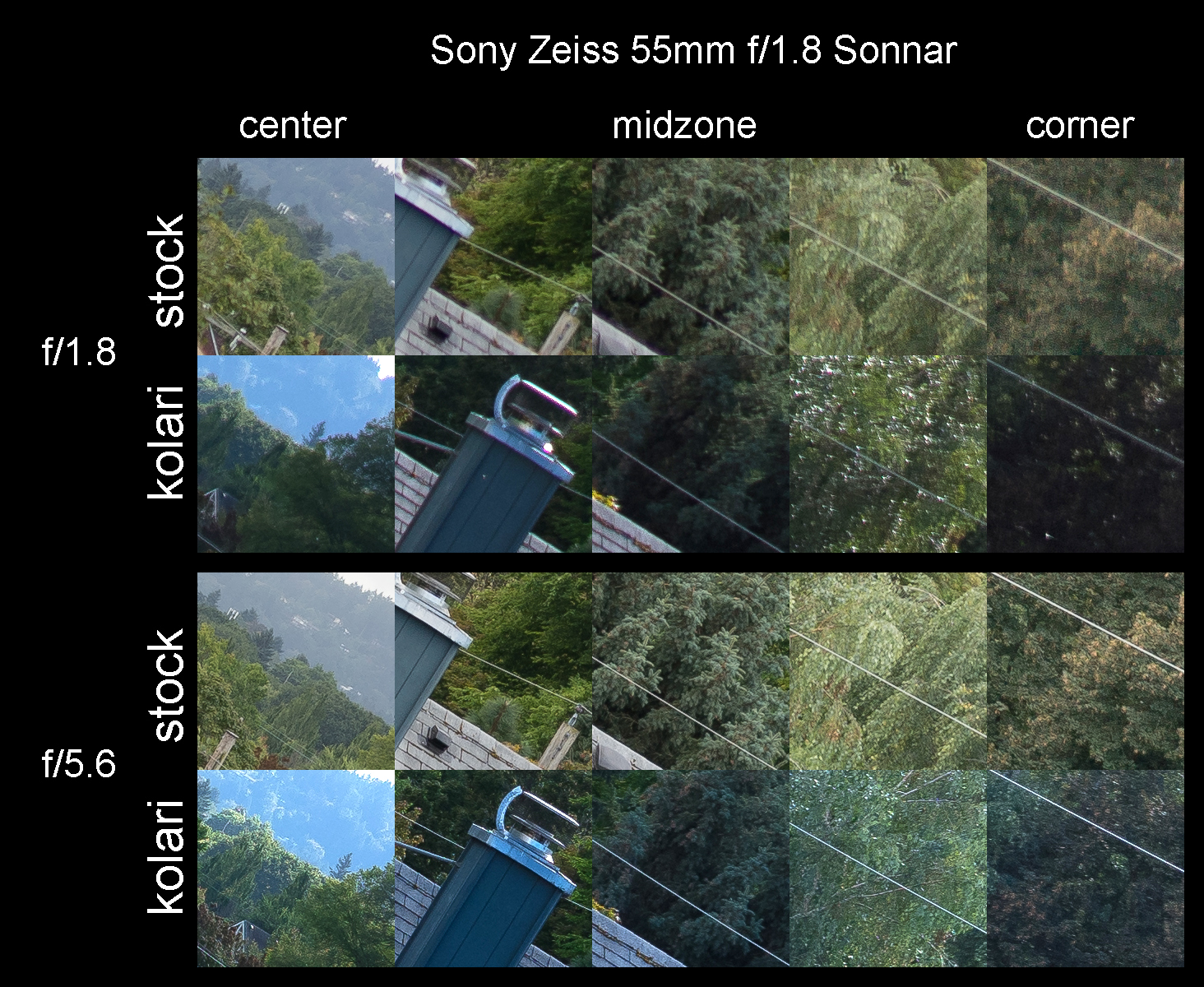
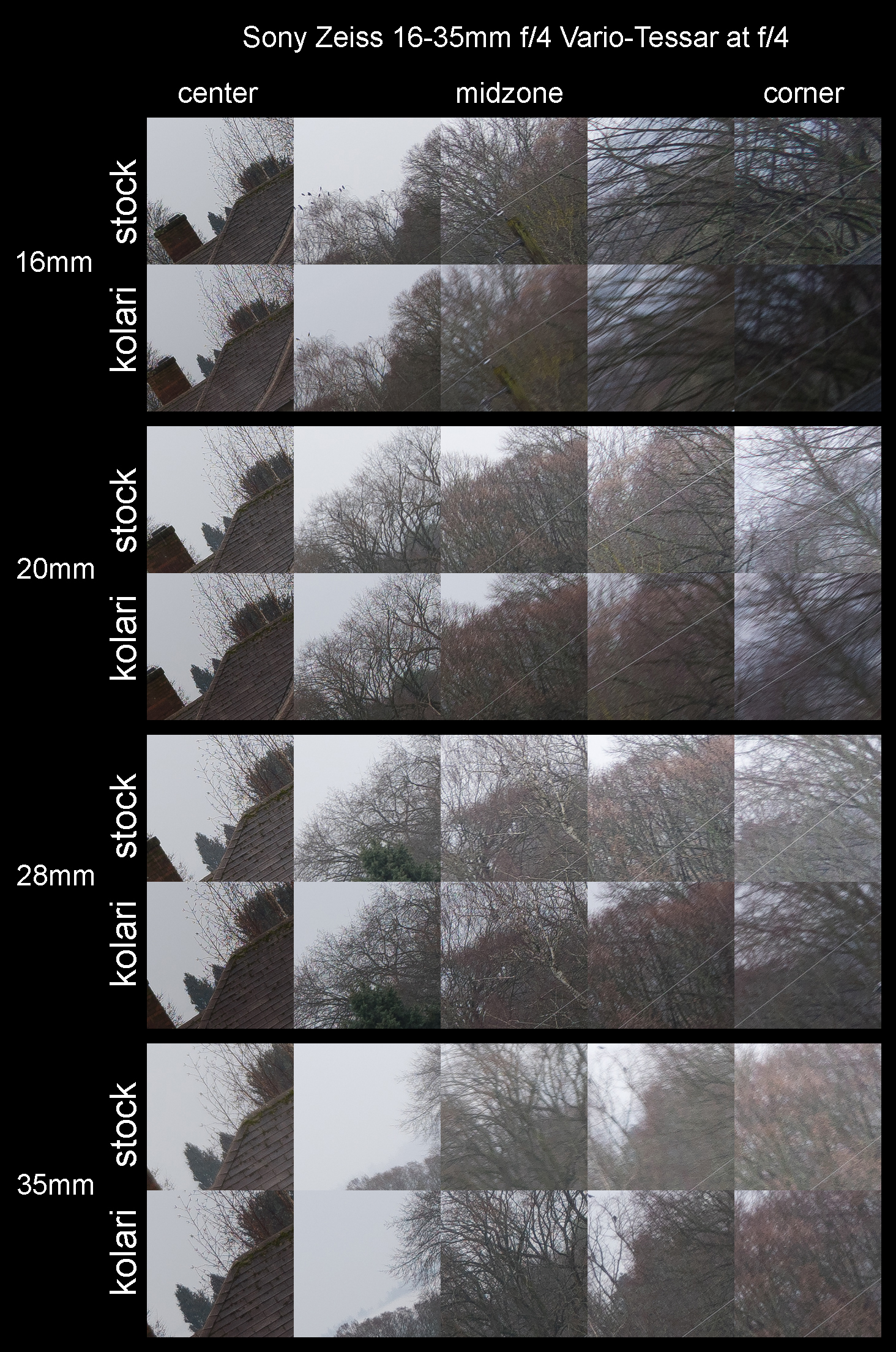
On the whole I found that FE lenses were totally usable for me on the Kolari UT (the FE 35/1.4, 55/1.8, and 85/1.8 were the only native lenses I used outside of testing). The differences that showed up in infinity tests were much smaller shooting 3D subjects at closer distances. The increase in inward field curvature actually tended to improved corner bokeh a bit at large aperture while being negligible stopped down with lenses 35mm or longer.
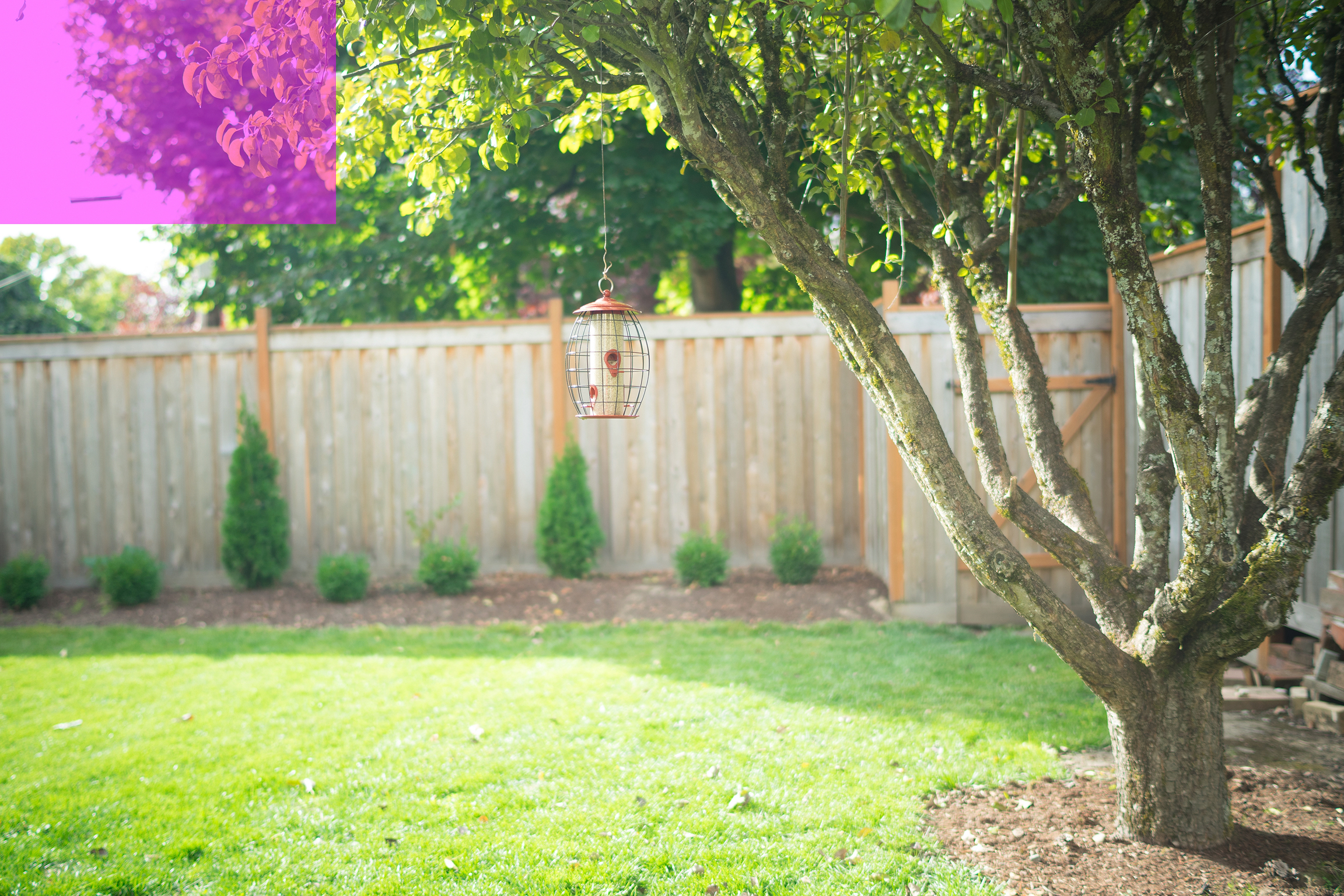
Performance with SLR Lenses
As predicted by Roger Cicala at Lens Rentals, the thinner filter stack leads to an increase in performance with high speed SLR lenses. This performance boost occurs centrally as well as towards the periphery, but is generally pretty modest.
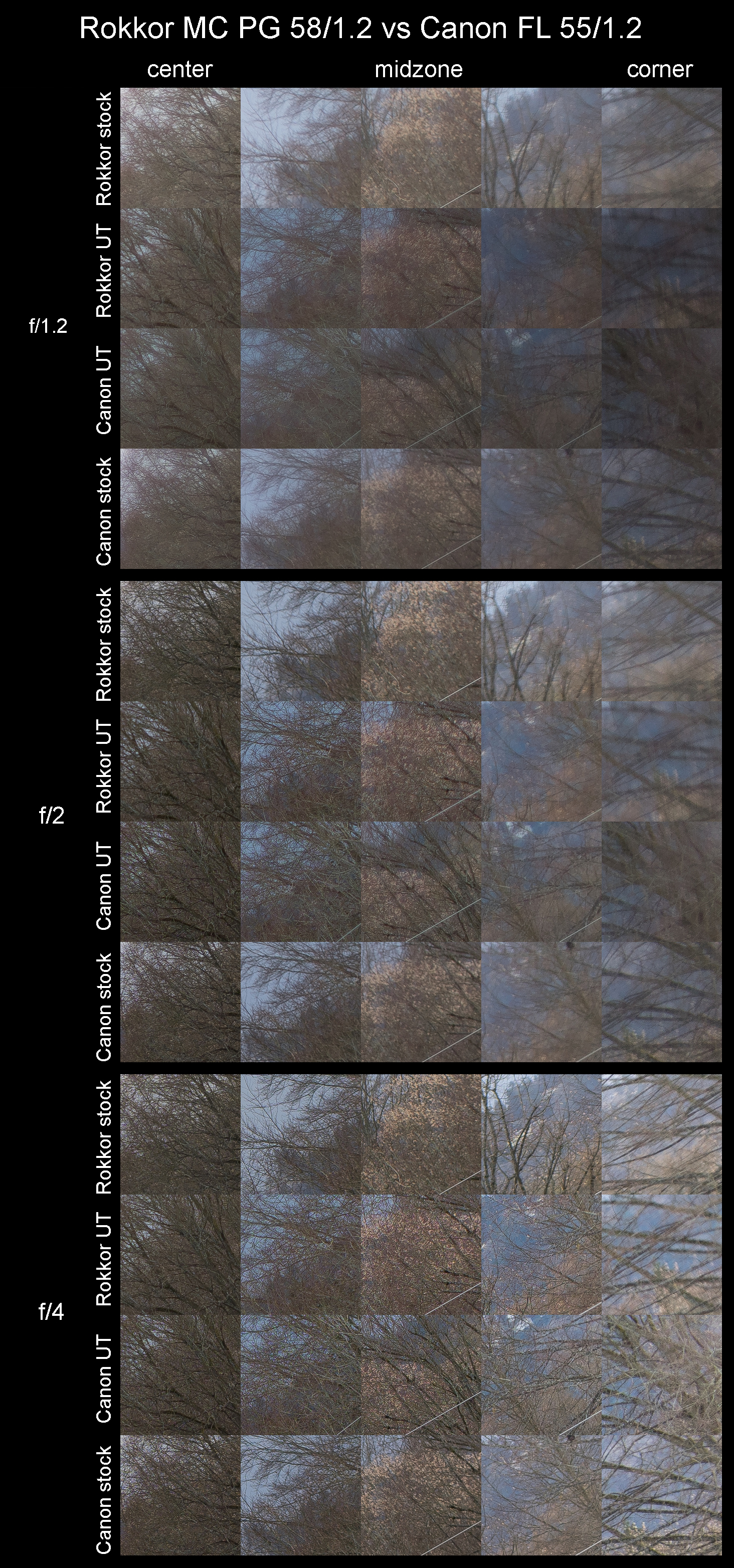
I’ve heard a few people claim that specific SLR wide angles showed large improvement with a thinner sensor stack. Unfortunately, none of mine showed any particularly noticeable improvement. There does seem too often be a mild change in the field curvature pattern for some of my lenses. Usually this results in a improvement in one part of the frame (midzone or corner) and a reduction in performance in another part of the frame. Perhaps testing faster wides would yield more difference or better corrected wides, but my overall conclusion is that in most cases it won’t make any real difference to slower SLR lenses (the widest SLR lens I tested was the Soligor 21mm f/3.8 and the fastest wide angle was the Pentax 31mm f/1.8).


Sensor Reflections
Improvements in sensor reflections may be there compared to a stock A7, but they are not obvious. I did not get a good opportunity to compare the A7 Kolari UT directly to the stock A7 in this regard, but I did not notice any improvement in my day to day shooting with the A7 Kolari UT. Sensor reflections were still easy to provoke with a bright light source near the edge or corner.
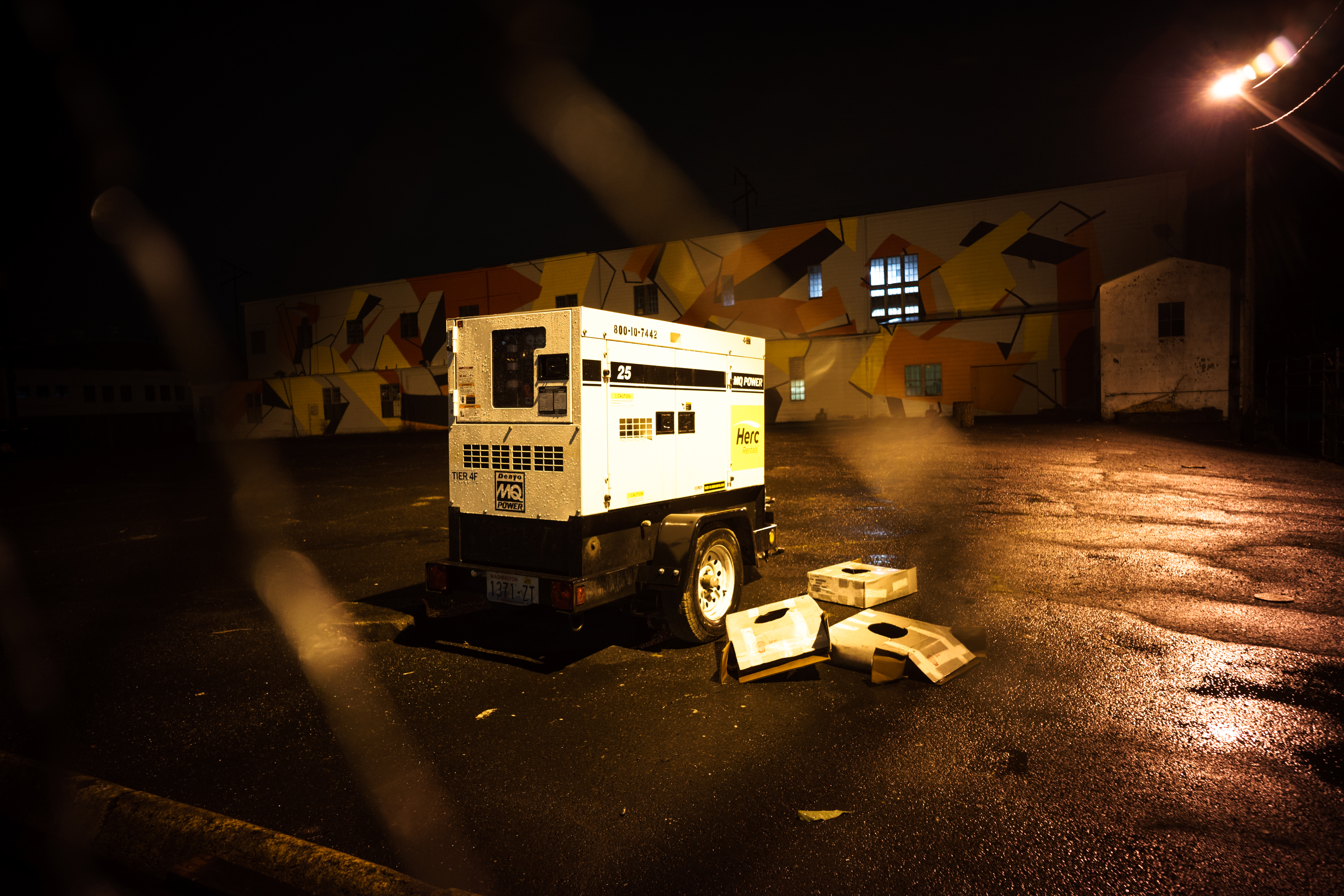
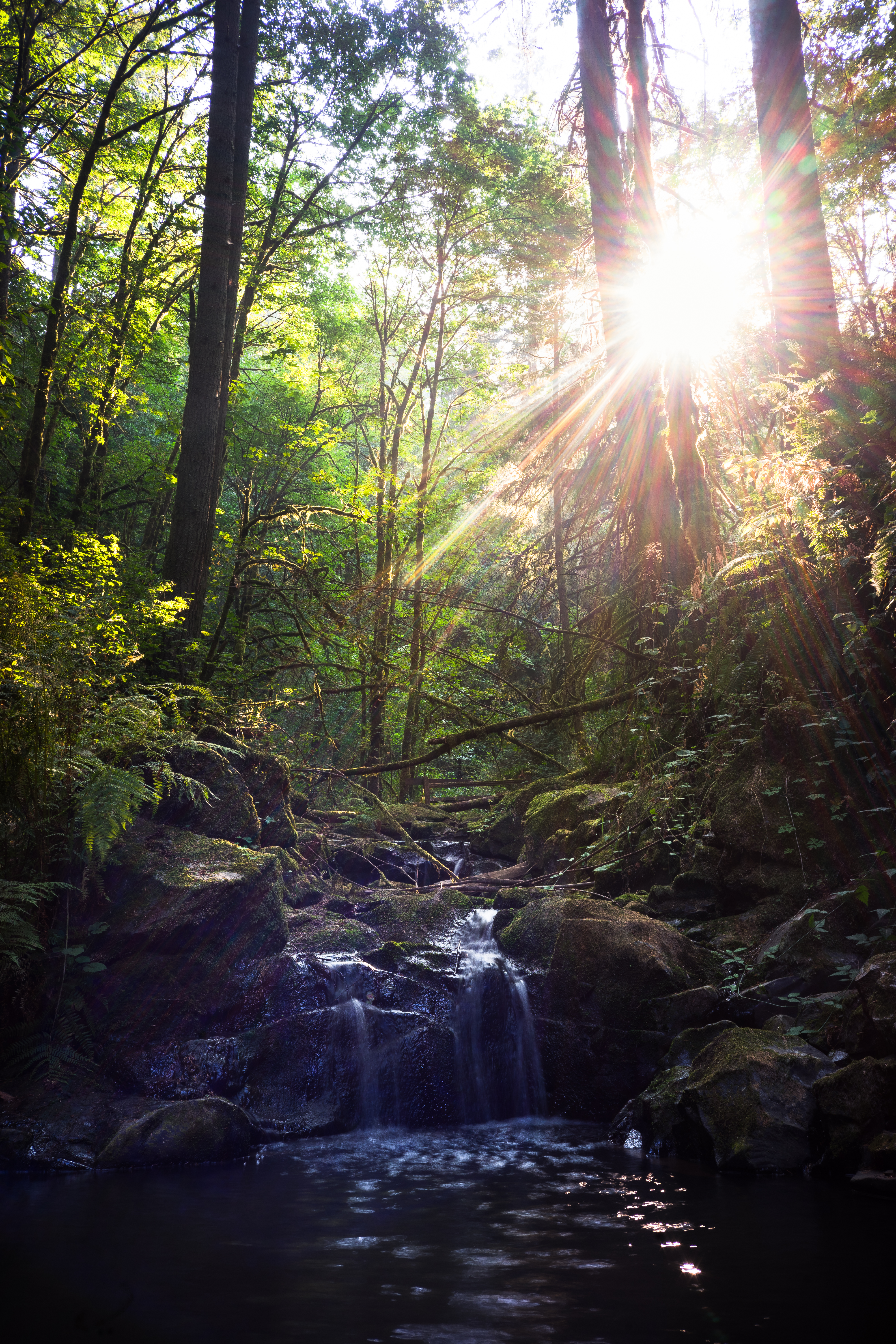
Auto Focus
AF did not seem to be effected by the modification, but I only used it about 5 times and only to test that it worked.
White Balance
The UT mod totally changes the color balance hitting the sensor. This makes auto WB pretty much unusable – images come out way redder and yellower than they should. Typically adjusting temp down 1500 and tint down 54 in LR from what they would be with a stock Sony A7 seems to work for me. Using the custom WB with a grey card also seems to work fine. Unfortunately, in extremely yellow orange lighting conditions the temp setting cannot be lowered enough to get proper white balance (I have only experienced this in settings where vintage orange light bulbs are used).
Dust
The thinner cover glass on the Kolari modded camera means that dust sits closer to the actual photosites of the sensor. This means that any dust on the cover glass will show up much more easily. Prior to getting the conversion I pretty much never cleaned my sensor, now I can often see dust even at f/2.8 and feel the need to regularly use the rocket blower to get rid of as much as I can. Kolari tells me that the Sony recommended method for wet cleaning of the sensor should still work fine (I have not tried it), but that one should be extra careful as the thin filter is more delicate. They advise to try cleaning methods with no direct contact first.
Aliasing
The UT mod gives greater moire and other digital aliasing artifacts than the stock A7 or A9. I never found these to be terribly intrusive, but I also don’t shoot much in the situations where aliasing is typically a big problem. I presume that there isn’t really a difference in aliasing between a modded or stock A7R* since those already are without and anti-aliasing filter.
Alternatives
Using front filters: These are cheaper if you are only using a 3 or less lenses that need correction (depending on your location) and prevent any image degradation using native lenses. Unfortunately they don’t work for all lenses and often require lens modification to allow infinity focus. They are also not nearly as effective on lenses designed for digital rangefinders as the UT sensor stack modification. For film era rangefinder lenses I’ve found that front filters can often do a better job of flat field correction than the UT mod, but usually at the expense of a worse midzone dip. For these lenses a combination of the UT mod and front filters produces the best results.
Shooting rangefinder lenses with no correction: I have done this for some time and found it quite rewarding. This requires being particularly mindful of the limitations of your gear. One needs to either pick lenses that are not terribly impacted by the thick sensor stack or shoot around the sensor stack induced weakness. It also requires the personality type that won’t be troubled by lenses not living up to their theoretical potential performance.
Shoot strictly native or SLR lenses: This is the easy and obvious solution. The main downside is size. Even the small native lenses have rangefinder equivalents that are noticeably smaller (e.g. the Zeiss Loxia 21mm f/2.8 Distagon compared to the Contax G 21mm f/2.8 Biogon or Leica Summarit 21mm f/2.8 ASPH) and for fast lenses the difference can be dramatic (e.g. the Leica Summilux 35mm f/1.4 FLE compared to the Sony Zeiss 35mm f/1.4 Distagon). In addition, there are some special lenses that just don’t have real native equivalents like the ZM 50mm f/1.5 Sonnar.
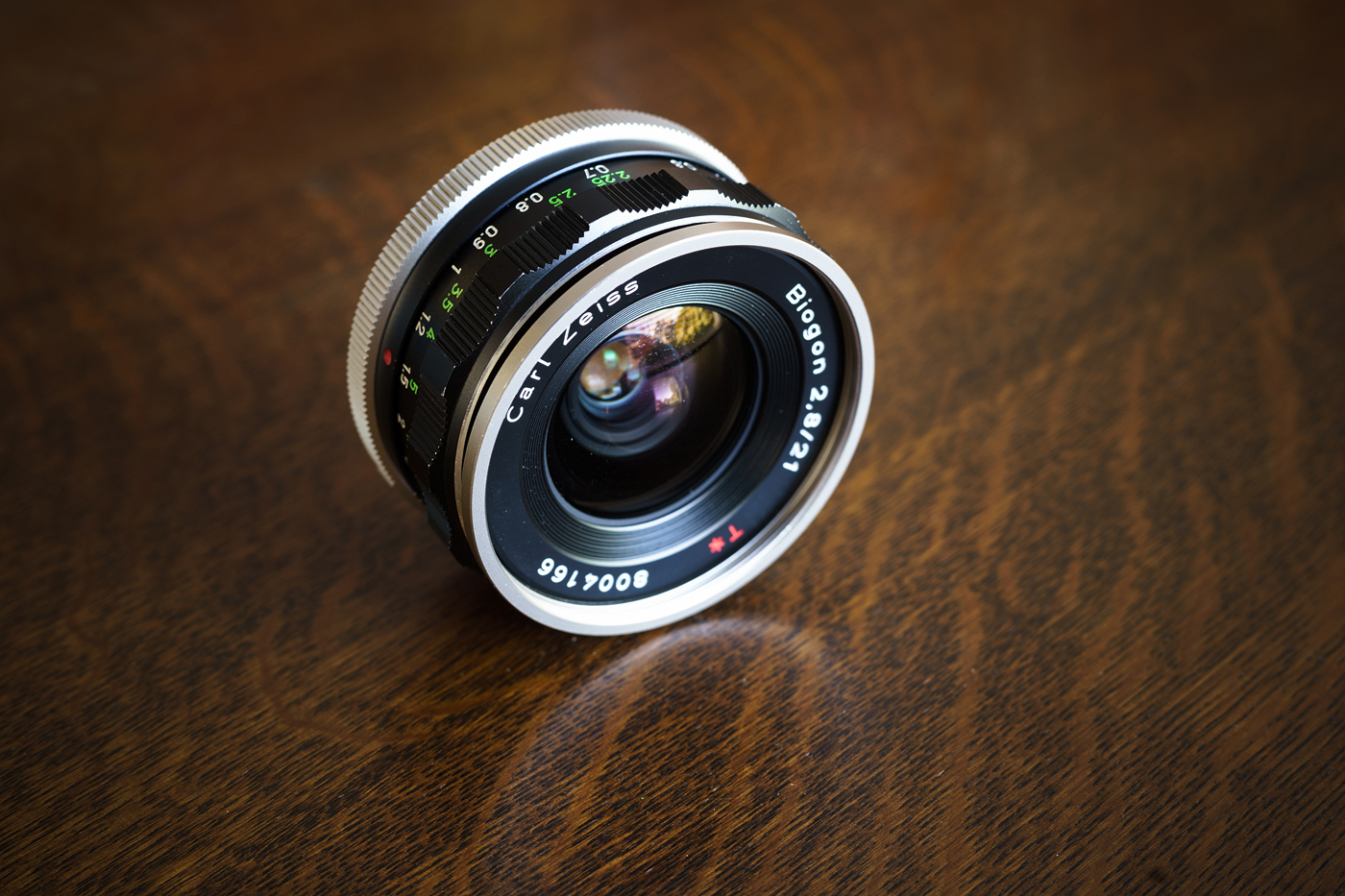
Conclusion
I have never had an interest in autofocus (or modern lenses for that matter) and have been particularly drawn to mirrorless for the size reduction it allows. This makes me the perfect candidate for thin filter conversion. All of my lenses perform as good or better with this conversion than on a stock Sony camera and many of them perform much, much better. This conversion allows me to build a solid kit of really tiny lenses that includes ultra-wides. Pancakes like the CV 21/4 and earlier versions of 15/4.5 are suddenly much better performing and all my Contax G lenses are fully usable. For me, this conversion is a no brainer.
If you use native E-mount lenses, the equation becomes more difficult. I would not worry about the performance of any of the 50mm or longer FE lenses, but many of the wider lenses really perform noticeably worse with the conversion. If you want to use one of the Batis wides or the 21mm Loxia for large aperture landscapes or astro, this conversion is probably a bad idea. If, on the other hand, you are only interested in using native lenses for stopped down landscape and portraiture, the conversion could make sense. I actually think that the FE 35/1.4 improves for portraiture on the Kolari UT.
The big deciding factor for me on whether the conversion is worth it would be how much of your shooting will involve lenses that show a noticeable improvement. If you see yourself doing 50% or more of your shooting with 35mm and wider rangefinder lenses, the UT conversion should be totally worth it. If you will only occasionally be dabbling in such lenses, the conversion does not really make sense.
Sample Images
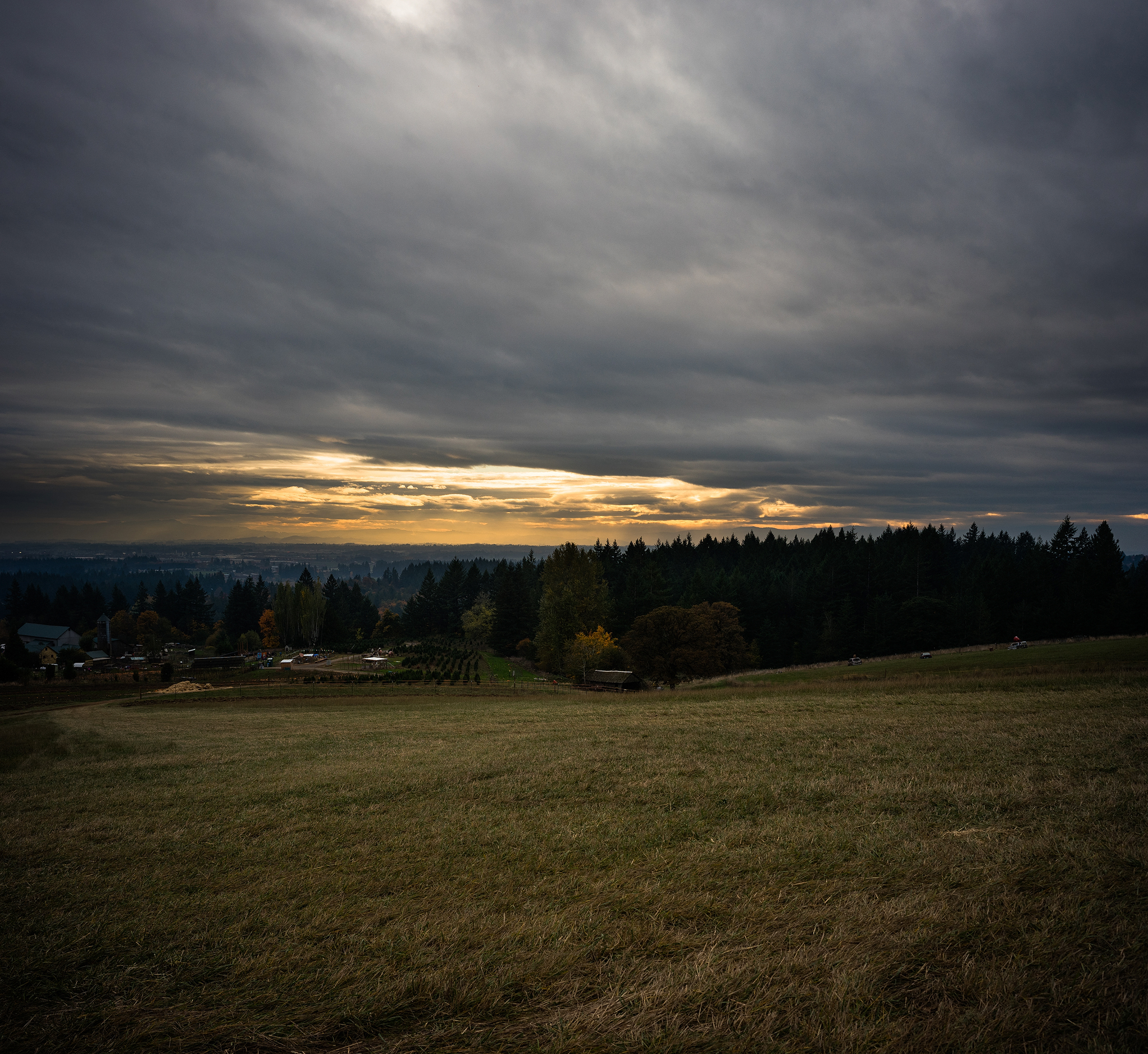
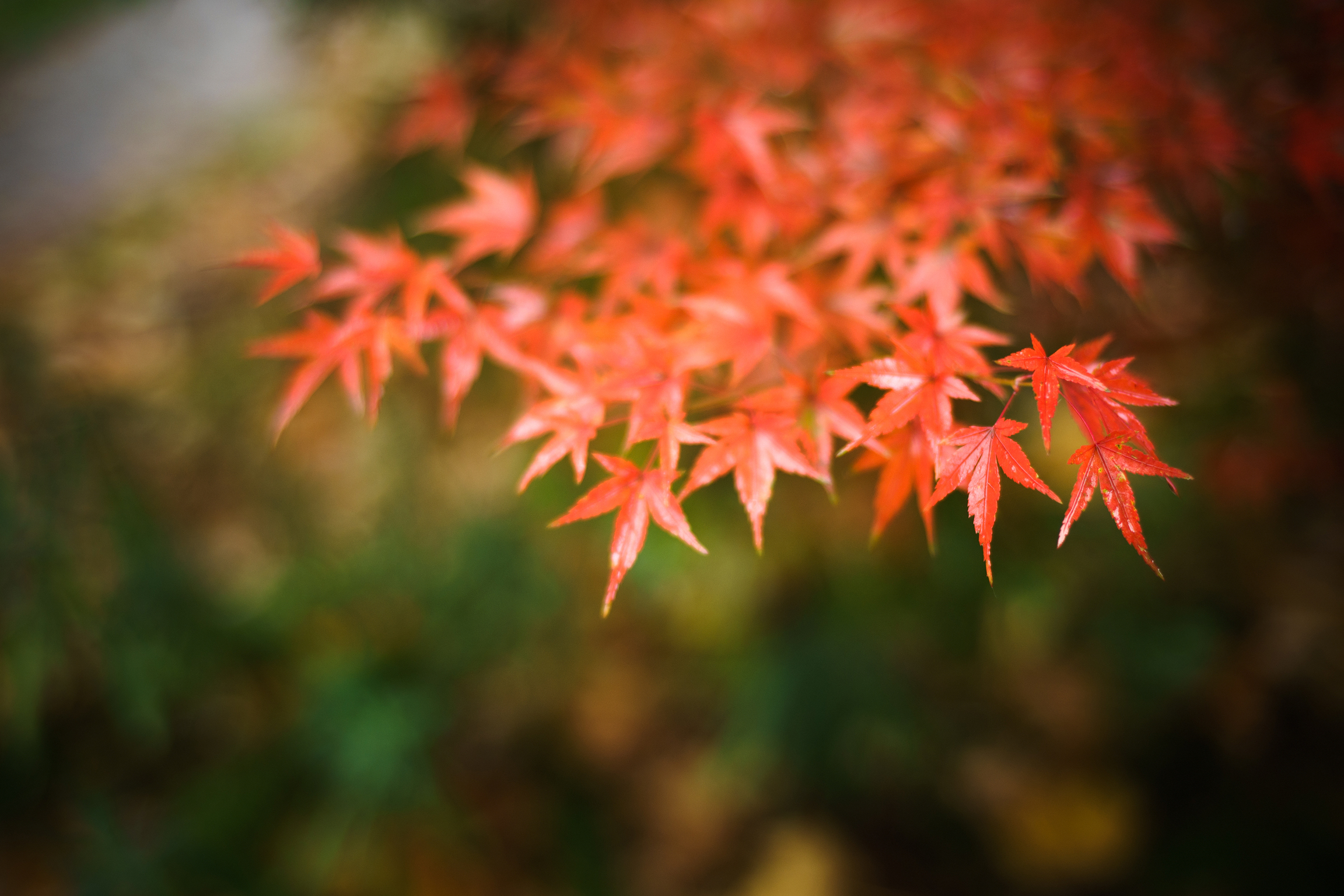
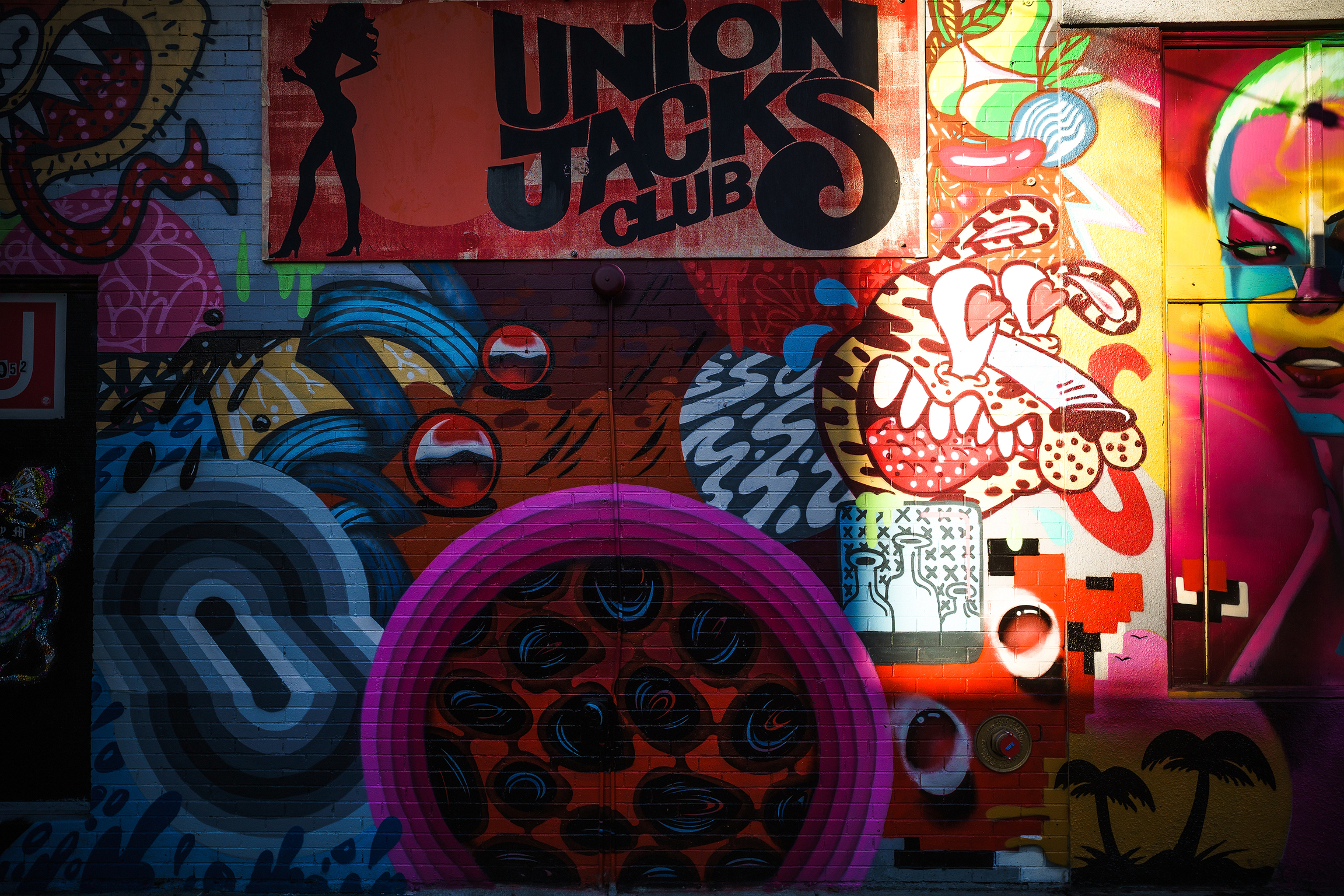
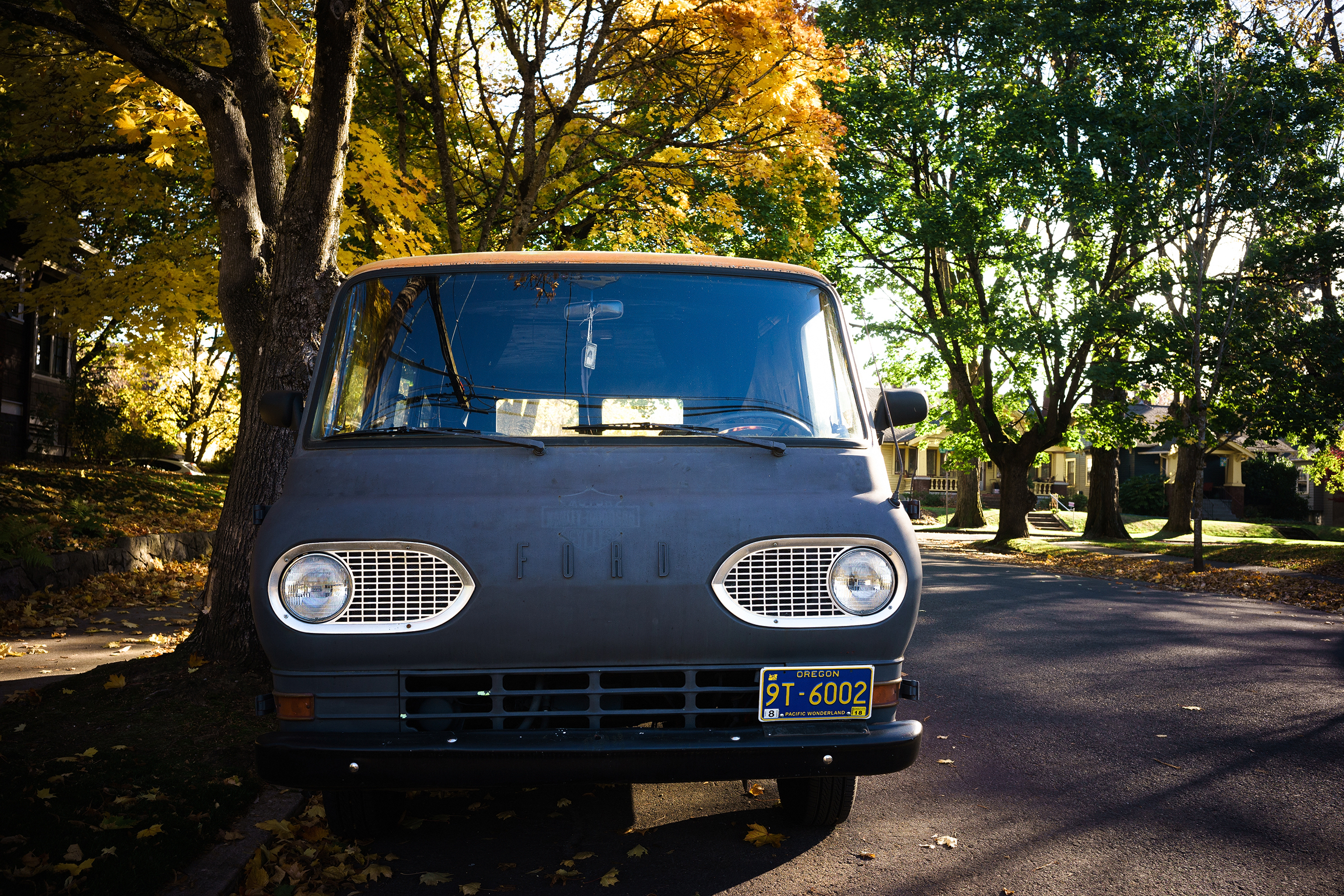

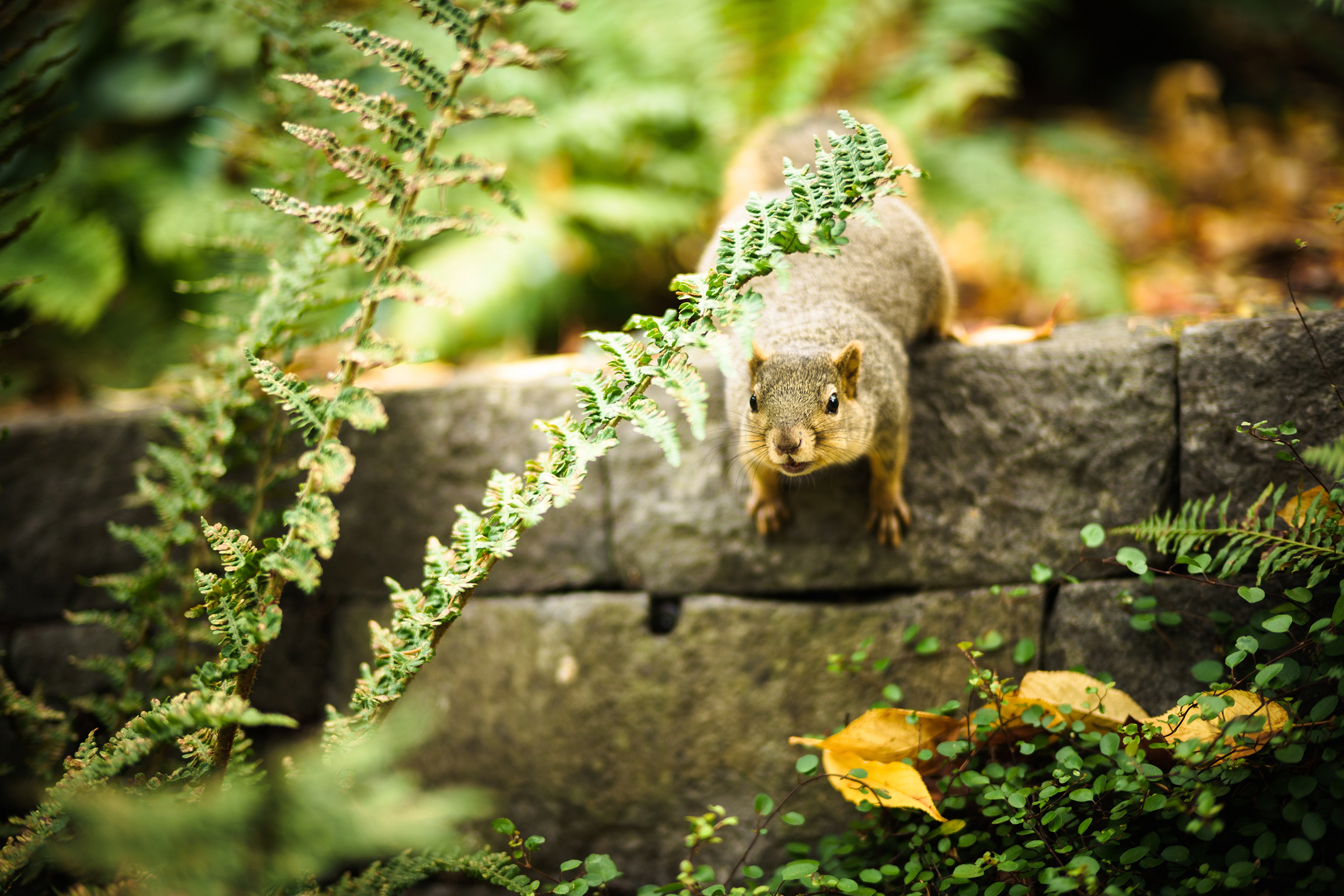
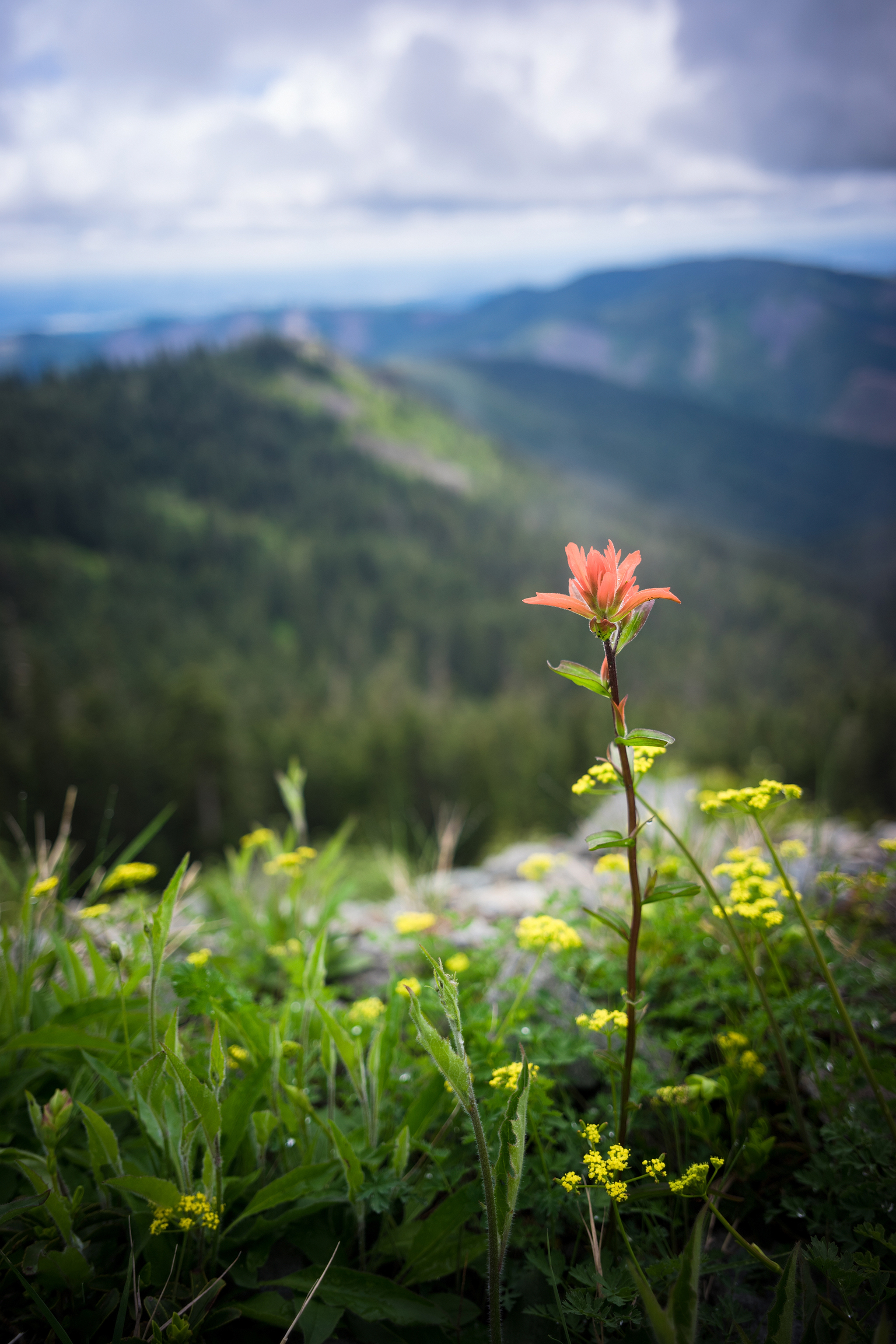

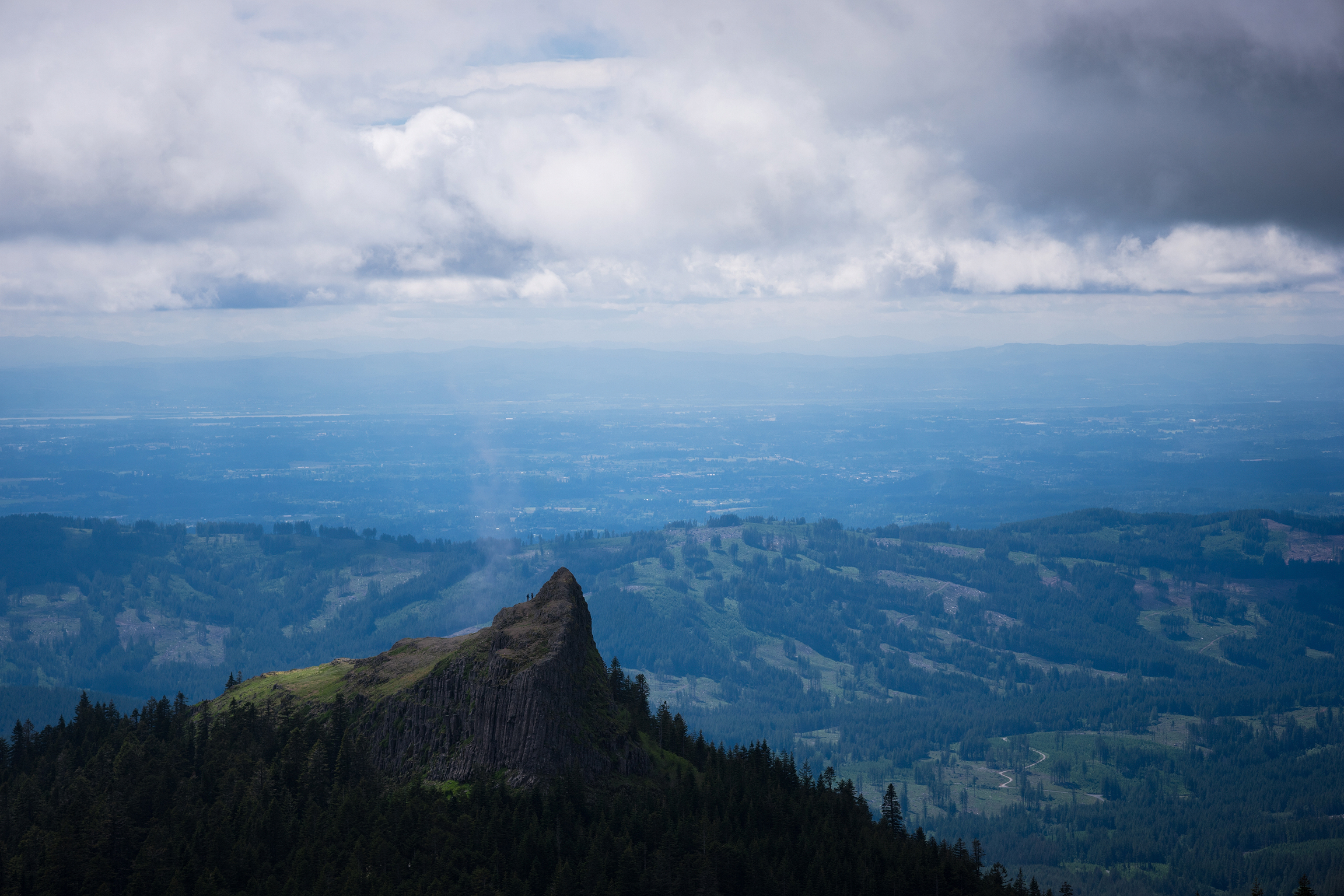
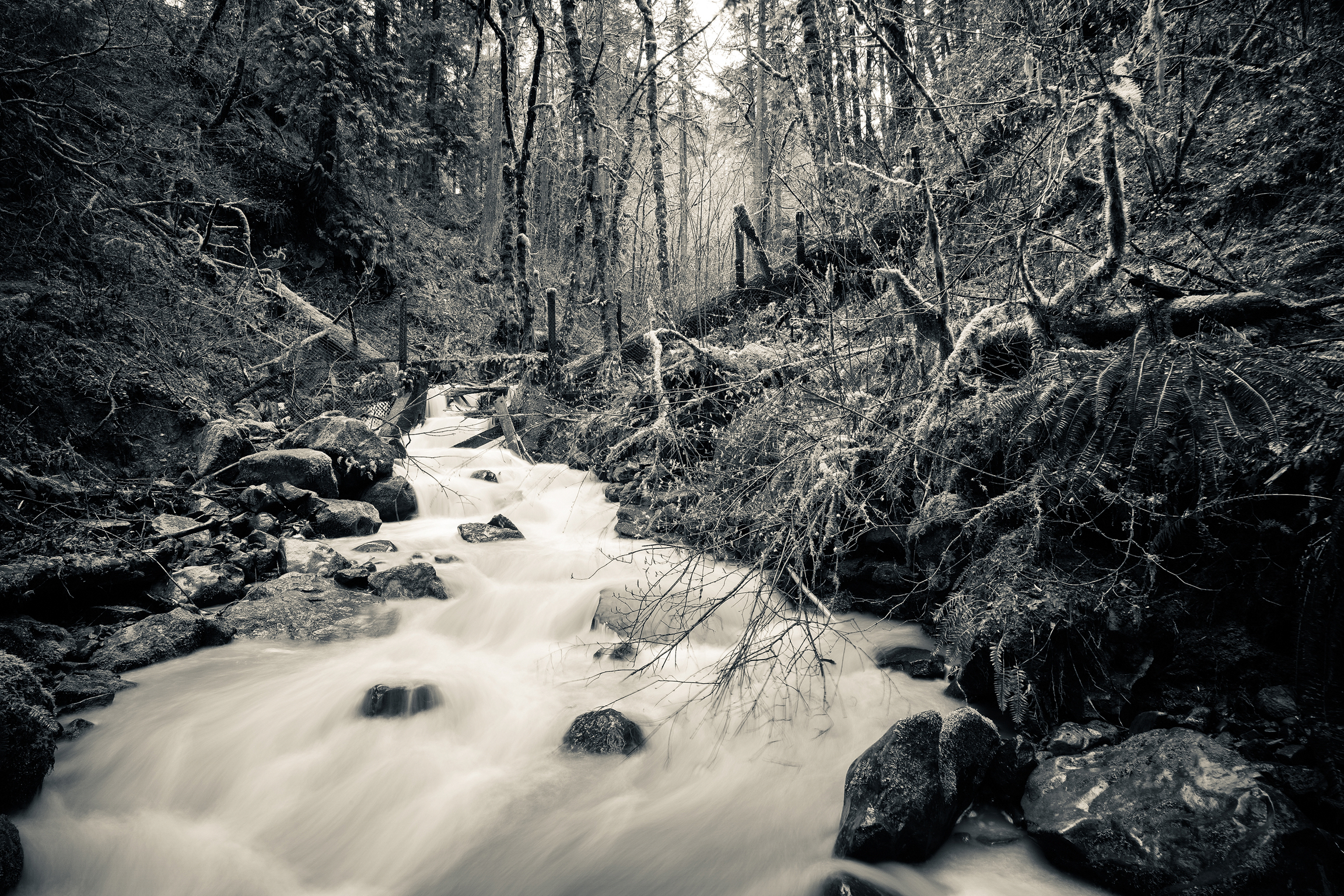
Support Us
Creating comparisons like this takes a lot of time, so if if you found this article useful or just liked reading it – why not treat us to a coffee?
![]()
![]()
![]() via Paypal
via Paypal
Further Reading
sebboh
Latest posts by sebboh (see all)
- REVIEW: Carl ZEISS 28mm f/2.8 Biogon T* + 1.5m pcx filter - February 18, 2018
- Review: Kolari Ultra Thin Sensor Stack Modification - November 14, 2017





Great post Sebboh, thank you for sharing your findings!
Has anyone reading this tried the Zeiss Loxia 21mm f/2.8 with the Kolari UT mod? My kit is a7rii with Zeiss Loxia 2.8/21, Zeiss ZM 1.4/35 (w. front filter), and Zeiss ZM 4/85. I’m wondering if the gains with the ZM would be worth slight deterioration with the Loxia. Thanks!
I have not seen one. I’m guessing it would have similar deterioration in performance to the 18mm Batis. I suspect the Leica 21 SEM would have similar performance on the UT to the Loxia on a stock Sony. I was very impressed by the Leica 21/2.8 ASPH on the UT as well.
Thanks for clarifying!
It should be different. The Nikon Z has a thin filter stack and there was someone that tested the Loxia 21 on that system with great(er) results, sure the Kolari is even thinner, but without someone testing it we will never know for sure.
https://blog.kasson.com/nikon-z6-7/loxia-21-2-8-on-z7-and-sony-a7riii/
I only use Minolta Manual lenses so I suppose this makes it useless.
It does.
thank Sebboh , u did a great job
Can u show us the AWB on KV UT ver for us? it seems that u said it is unusable.
hope it can add AR coating on thin filter so that there will be less dust problems in the future
I hope to see KV removed the cover glass ver + UT Testing in the future.
I didn’t post AWB samples because they are wildly inconsistent. Sometimes it’ll miss in one direction, sometimes it’ll miss in the opposite direction. Charlie posted some photos taken using AWB here: http://www.fredmiranda.com/forum/topic/1465200/11#13967265
I’ve found just leaving WB at temp 3900 and tint -39 gives me decent daytime results.
Kolari tells me there is an AR coating on my UT. I believe the dust issue is just due to glass thickness (and my sloppy and frequent lens changes).
Great Article!
For me the result for the Leica \ Minolta 40mm 2.0 M mount Lens would he interesting.
If anybody …
Sadly I sold my 40 cron before I got the UT (was always using the 35 lux pre-asph instead). Perhaps I can find another to try out sometime.
Great article!!! I wonder what will be the effect of this UT mod to a A7rII body since its sensor is back illuminated and it is getting cheaper now… In theory this can be the ultimate rangefinder lenses camera body.
Yes, the A7rII with the UT mod shows all the improvements without the weird color casts and also seems to have less vignetting.
Wow, that sounds very interesting! Does this apply to the a7RIII as well? I have been tempted to get a 2nd hand a7RIII and send it in for a Kolari UT mod. If the results are that good with the 42,2mpx sensor, I’d say one could take advantage of the ZM & VM lenses far beyond any abailable digital Leica camera and build a unique and fine rangefinder lens kit.
Do you know if there any detailed accounts of the UT mod on a7RIII cameras?
Thanks for the formidable effort to report on the Kolari thin filter modification.
I haven’t heard from anyone using UT modded A7RIII cameras, but the A7RII with UT mod shows the same level of improvement as the A7 UT I used in this test with less color smearing than on leica cameras as well. I would think the A7RIII would be the same. For using rangefinder lenses for landscape, any of the A7R cameras with a UT mod should make significantly better large prints than a leica m-camera with the same lens.
Hello,
Thank you very much for making this article. I was wondering if I needed to do this to improve the performance of my Canon nFD lenses. However, you may have convinced me to hold it off. Have you tried with any nFD lenses wider than 20mm? I have a 14mm 2.8L and I want to know if this at least reduces the coma which suffers terribly with the A7. Thanks.
Nico
Sorry, I have never shot the FD 14/2.8L (I didn’t shoot any SLR lenses shorter than 21mm on the UT). I won’t say that the UT won’t improve its performance, but I would not be surprised if improvement is pretty small.
is there any way to test this modification with the new Voigtlander 40 1.2?
Yes, by me or somebody else with a UT conversion getting a cv 40/1.2 and testing it. I will probably get an m-mount version to test out, but that will probably perform differently than the e-mount version.
I dont mean to be an annoyance but Im very curious about this lenses performance in the M-mount version on the thin sensor. I saw in your post on FM that you were getting one and I wondered if you had any thoughts or images to post from it if at all possible. Thank you
I don’t have one yet and don’t imagine I will get one till sometime after the new year. Once I get one I will probably post a quick summary of performance on the thin filter vs stock sensor.
Thank you for your reply and for the time you put into your review
I’ve read that the C/Y 28mm F2.8 performs better on a Canon DSLR than the A7’s, so it’s disappointing that the filter mod doesn’t seem to help with SLR lenses.
Thanks for the great review, Sebboh.
I have read that as well but never seen any evidence to back it up so I am a bit sceptical. If it actually performs better on film it should also perform better on the mod.
The UT sensor mod does change the field curvature patterns of some SLR lenses, just not very much for the ones I’ve tested. It’s entirely possible it will have a larger effect on different lenses. I would like test c/y 28/2.8 to verify as I have heard that too. I’m not eager to spend $300 for a lens I don’t particularly want though. It seems most of the people who have seen a difference with the lens on Sony vs Canon are in fact using different copies of the lens years apart, so it’s possible they are really just seeing copy variation (which seems to be fairly high in this particular lens).
Excellent review.. also love your work! Would it be possible to post another article about using the the Adobe Flat Field plug in to remove the magenta color casting? I think this article would get a lot of hits and be very useful because it seems that everyone mentions it but not one actually tells you their exact steps for doing it.
I’d be happy to post a how to about using the flat field plug in. Not sure it merits a full article, I could include it in the review I’m writing of the Contax G 28/2.8.
Would love to have a full article. Doesn’t need to be very long 🙂
I wonder, would attaching a 1.6mm thick UV/IR cut filter to the rear of a native FE lens provide curvature-free images with accurate AWB on a Kolari UT modded camera… I’m sure there would be internal reflections to consider.
My guess it that it makes a difference whether that 1.6mm filter is on top of the sensor or closer to the lens.
But maybe that difference isn’t too big.
Would be interested in somebody with a Kolari modded camera trying that out 🙂
Interesting idea. Lets assume it would work: could one source such a filter and how would it be attached.
Like this: https://stcoptics.com/en/clip_filter/
I’d be curious to find out, will check to see if I can get good info on available filter thickness.
Interesting, didn’t know about those. Would certainly make the mod more attractive if it worked without flare issues.
Kolari should have a pretty big pile of the old ones with perfect thickness they removed from the cameras they modded 🙂
Do you think they will be intact and large enough?
I think they should be able to remove it undamaged.
And when I look in my camera that filter can barely be bigger than the cover glass.
I can ask them.
You probably want a little thinner than what they removed though since they don’t just remove it, they replace it with an ultra thin filter.
Point taken.
zeiss 35/3.5 from yashica t4/5 it is a tessar
You are correct. Perhaps I was wishing I had the 35/2.8 sonnar from the T3.
What about an Astronomik OWB (Original White Balance) Clip-Filter for Sony alpha 7 to correct Kelvin Shift?
I don’t know, haven’t tried it. Is it designed specifically to color correct the UT conversions or is it for full spectrum conversions? It would be counterproductive with rangefinder lenses because it reintroduces a thicker filter stack into the light path.
Thank you very much for the effort with all those tests, very informative.I would like to ask you – would you recommend to do the conversion in case of A7r2 with Canon 17mm TS-E and 24mm TS-E? I shoot architecture and use these about 80% of the time and often struggle with smeared corners.I use Metabones IV.
I can’t speak for either of those lenses specifically. The kolari mod should be closer to the canon cover glass, but is actually thinner which may cause some issues too. Not sure if the smearing could also be partially due to adapter issues.
Understood.Thank you for your reply.
Getting a Sigma MC-11 will mostly solve your issues. The Metabones adapters are too short.
I heard it about Sigma MC-11 already.I will give it a try.Thank you very much.
Another very interesting review. Just worth nothing that that Sony backlit sensors inherently have significantly shallower light wells which is why lenses don’t suffer the same colour edge characteristics.
Thanks for this interesting article. I have read it a few times and now considering the UT conversion. One thing which isn’t talked about much in the article is how the UT filter changes the colors (apart from the auto white balance).
When you edit a raw file with a UT converted camera, are you able to get the same balanced, natural looking colors as with a stock camera by just adjusting color temperature and tint, or do you need to adjust in a more advanced way in order to get the colors right?
I am asking because I have a full spectrum converted Sony a7 and when shooting regular photos with a “hot mirror” filter on the lens, I am supposed to get normal colors, but it appears that the hot mirror filter not only cuts IR, but also more red than a stock camera. This is seen in red subjects _even_after_ a custom white balance has been made in editing.
So, in short:
Is it your impression that the UT filter leaks infrared or cut more sharply in the reds? Or do you get the right colors by just doing a regular white balance by adjusting temperature and tint?
All the images in my review were processed using the same methods I use with a stock sensor camera except for the white balance. I suspect that the UT filter cuts less sharply into the reds, but I haven’t really seen any evidence of IR contamination. Color seems to come out just right with a simple white balance adjustment, except when in certain orange incandescent lighting situations where I cannot push the WB far enough to get normal looking colors.
Thanks for the clarifications.
This article is a fantastic help on the merits of this conversion. Thanks for your efforts!
I’m curious if the benefit of the conversion is more beneficial the wider the rangefinder lens is. For instance, I frequently shoot 35mm RF lenses on my Sony, some 28mm RF but not much wider. Is the benefit of the conversion for a 21mm RF lens greater than for a 35mm RF lens? Or is it lens dependent somewhat?
Thank you for this useful and detailed article!
Is the sensor reflection an issue of a7 only or does it also affect a7s?
It also depends on the lens but compared to the original A7 it is almost a non-issue with the A7s.
Very interesting article, thanks for publishing it!
It is from 2017 and mentions UT modifications for A9 and A7rIII. Today, the Kolari Website lists modifications for most Sony mirrorless, but only for 2 (older) Canon models.
Why is that? Do newer Canon models not profit from UT filter stacks, if used with UWA rangefinder lenses?
I think it would be a good idea to ask Kolari.
I am weighing this conversion for my A7C. Seems most factors are in my favour.. I use almost exclusively vintage rangefinder lenses, most LTM, a couple M mount. I do shoot some vintage SLR lenses as well, mainly for the longer lengths. I don’t have a single Sony system lens..
I also never use AWB, shooting mainly in standard K temps or once in a while doing a custom WB off some grey or white in the scene. Does that custom WB functionality remain possible to use?
The increased dust spot sensitivity gives me the most pause.. shooting only primes, one is frequently changing lenses in all types of conditions. I always carry a blower but I still wonder if I would end up with too many spots on my image.. with wide angle shots there is always the possibility that the spot will be in an area of much detail.. hmm. hmm..
You can still use custom WB, you just need different values.
The dust issue is the most irrelevant one. No idea who came up with making it one.
Hey thanks for replying! I’m not sure I understand what you mean about needing different values for a custom WB.. I guess what I’m wondering is can you still take a reading off a neutral grey or white and capture a custom WB that gives the same look as it would with an unmodded sensor.
I never tried that, I always shoot raw and adjust the white balance in post.
Thank you for your work and an excellent article, Bastian!
I’m a new ZF user and will be going manual lenses only route. My scene is a street, day-to-day family, a tiny bit of a city landscape.
I would love to hear your opinion on which mount to go with for something like Thypoch Simera 28mm 1.4 (and then expanding with voigtlanders and thypochs).
I’m not considering native Z mount for thypoch as I want to use manual focus confirmation (plus some other lenses simply do not exist for Z mount), so my choice is between the E and M mounts.
I was able to to try both for a few days only and they seem to perform very similarly (via Megadap ETZ and Funmount MTZ), except I caught a pretty bad veiling flare on M mount once, but then I couldn’t reproduce the issue later.
Given the filter stack differences, the slight variation in lenses themselves (and all other scientific aspects), which system would you recommend adopting — M or E mount?